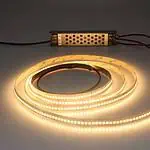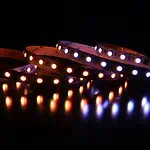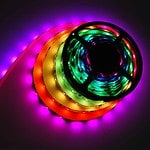LED strip lights are becoming increasingly popular in a variety of settings. Many people enjoy the modern look and feel that they create, as well as the fact that they are relatively easy to install. This article will detail how to wire various types of LED strips, including single color, tunable white, RGB, RGBW, RGBCCT, and addressable LED strips.
To better understand how to wire, we need to learn about voltage drop and parallel connection first. Additionally, please read the following articles:
RGB vs. RGBW vs. RGBIC vs. RGBWW vs. RGBCCT LED Strip Lights
The Ultimate Guide To Addressable LED Strip
How to Connect LED Strip to Power Supply
How to Cut, Connect and Power LED Strip Lights
How to Dim LED Strip Lights
A Complete Guide to LED Drivers
LED Controller: A Comprehensive Guide
Voltage Drop
The voltage drop in LED strips causes the section near the power supply to be brighter than the end, resulting in brightness inconsistency.
To avoid this, connect multiple LED strips to the power supply in parallel or use ultra-long constant current LED strips.
Another common solution is power injection. This involves adding additional wires at different points of the LED strip and connecting them to the main power source to ensure consistent brightness. End-to-end, midpoint, and parallel injection are the most popular methods. For more information, please read How to Inject Power into LED Strips.
You can also use this tool to calculate the conductor’s voltage drop: Voltage Drop Calculator.
Parallel Connection
The most common way to avoid voltage drop problems is to connect multiple LED strips in parallel to a power supply, controller, or amplifier.
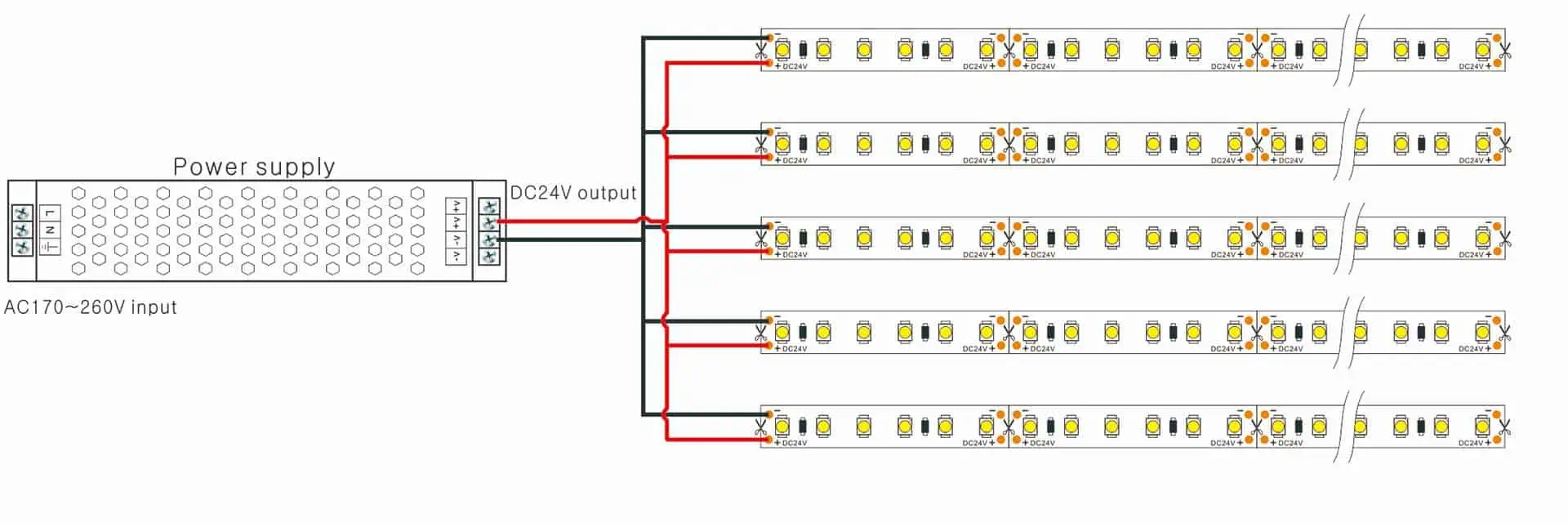
Another way is to connect both ends of the LED strip to the same power source, controller, or amplifier.
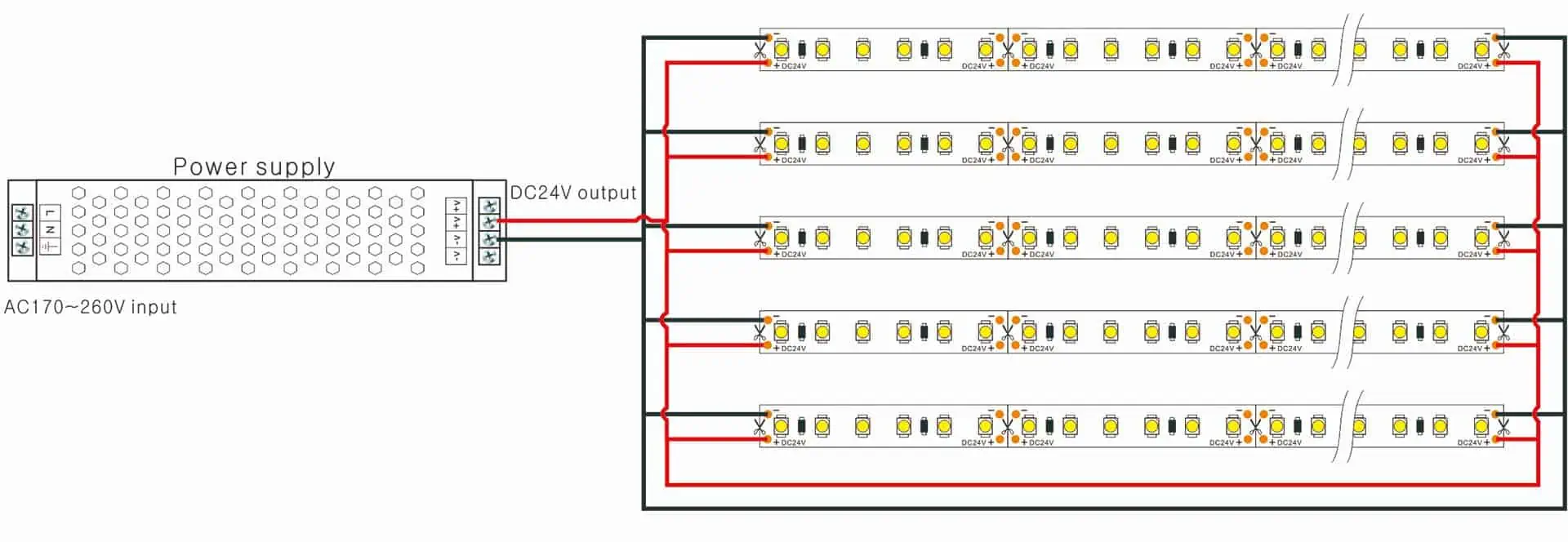
Be sure NOT to connect multiple strips in series to a power supply, controller, or amplifier.
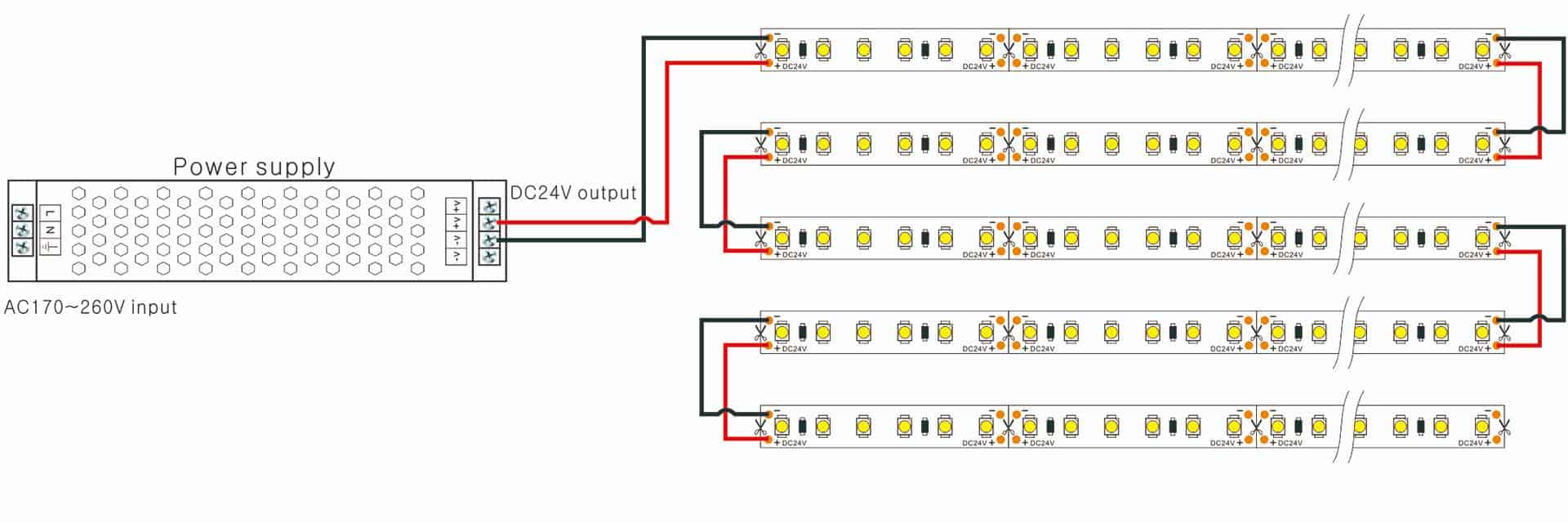
PWM Amplifier
All LED controllers output a PWM signal. If an LED controller does not output enough power, a PWM amplifier can increase the PWM power, thus allowing the LED controller to drive a sufficient number of LED strips.
How to Wire Single Color LED Strip Lights
The single color or mono LED strip light is the simplest. It only has two wires and can only emit light of a specific color.
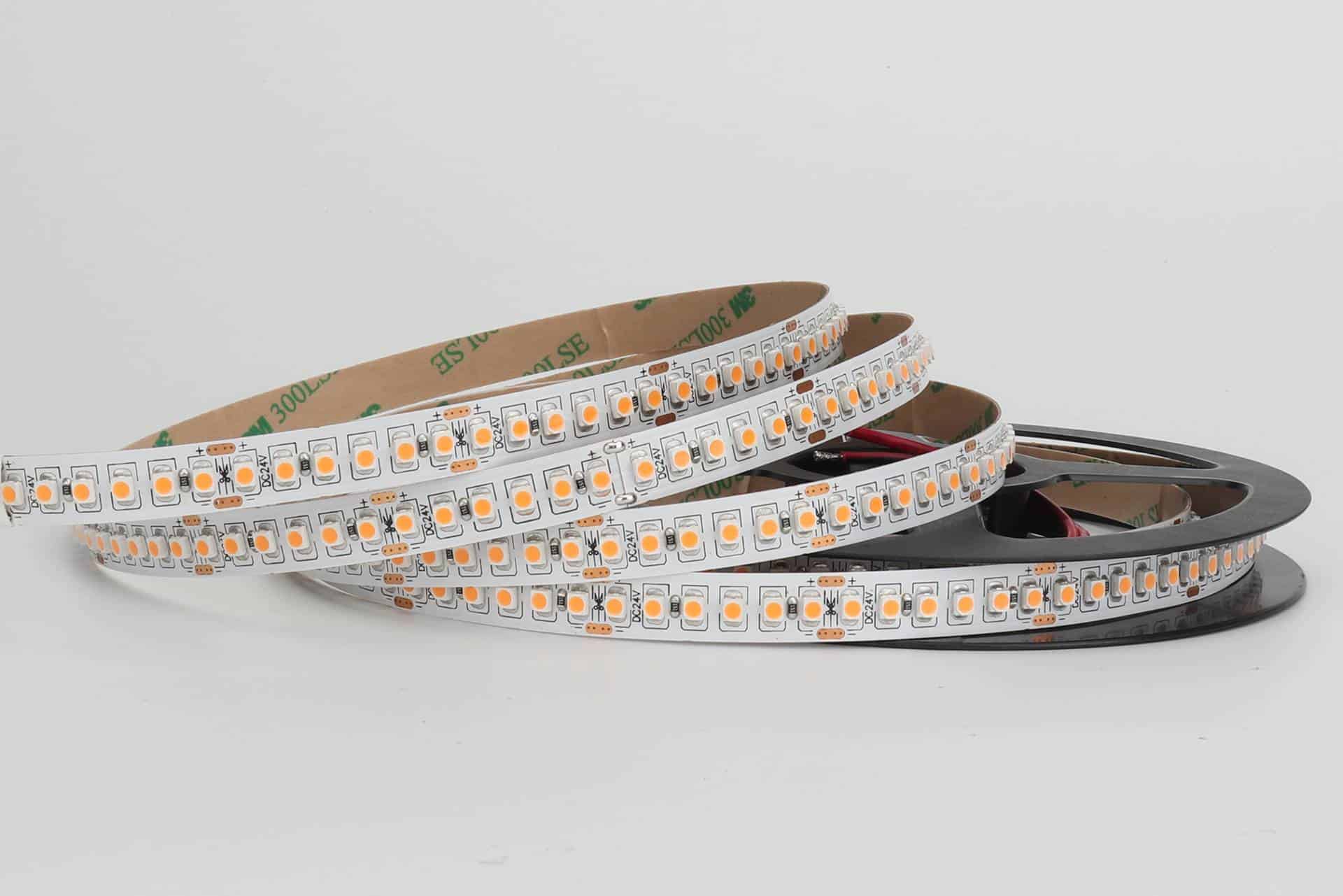
Wiring Single Color LED Strip Lights With Non-Dimmable LED Drivers
The most common is a single-color LED strip connected to a non-dimmable power source with no controller.
Please note that the power of the total LED strip lights should not exceed 80% of the power supply power, which is the principle of 80% of the power supply power.

Wiring Single Color LED Strip Lights With Dimmable LED Drivers
To adjust the brightness of a single-color LED strip, you need to connect it with a dimmable power supply. The most common dimming methods are 0-10V, Triac, and DALI.
If you want to learn more about these dimming methods, please read the following articles:
- The Ultimate Guide To 0-10V Dimming
- Everything You Need to Know About Triac Dimming for LEDs
- Everything You Need to Know About DALI Dimming
0-10V Dimmable LED Driver Connection Diagram
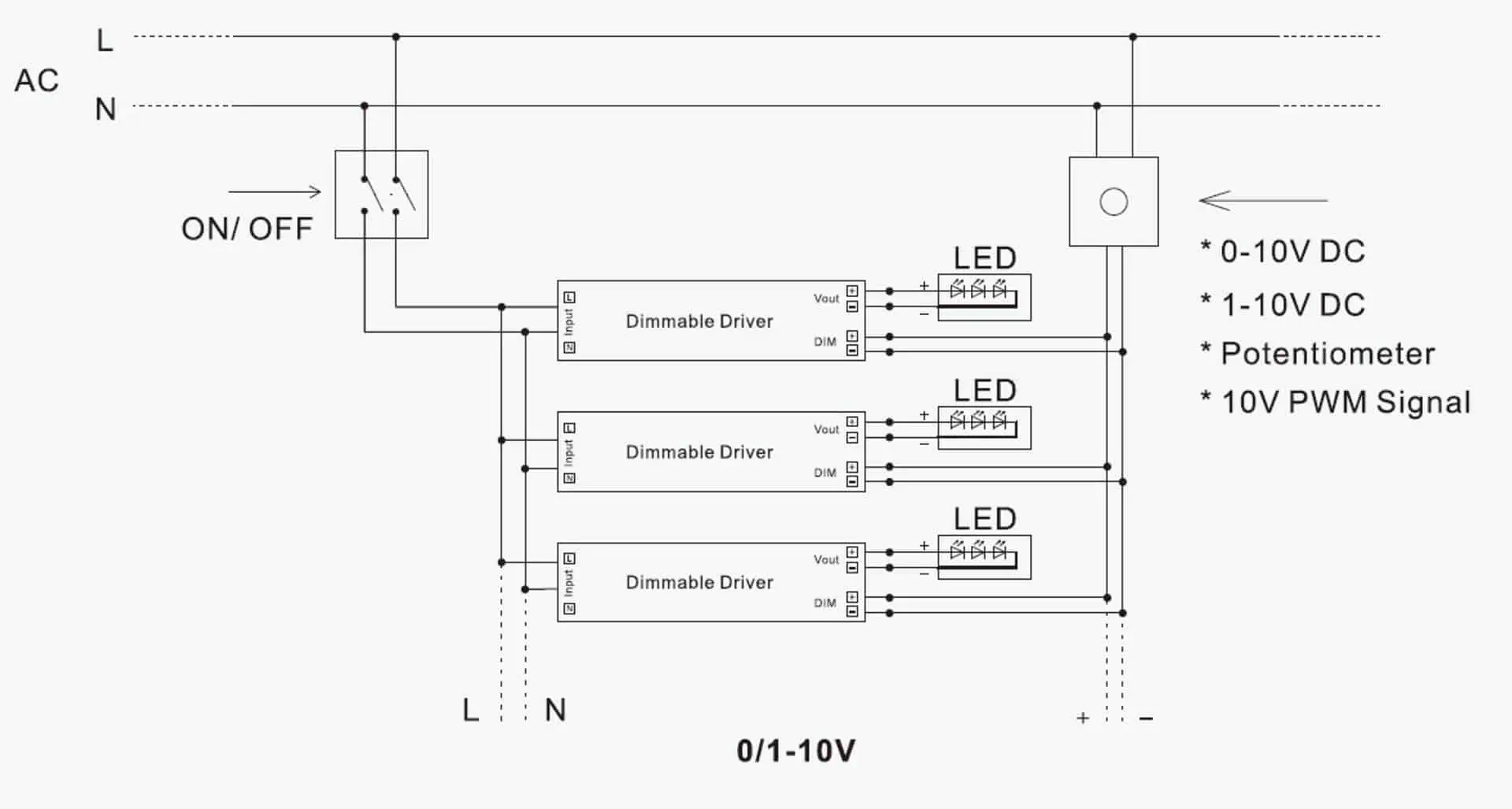
TRIAC Dimmable LED Driver Connection Diagram
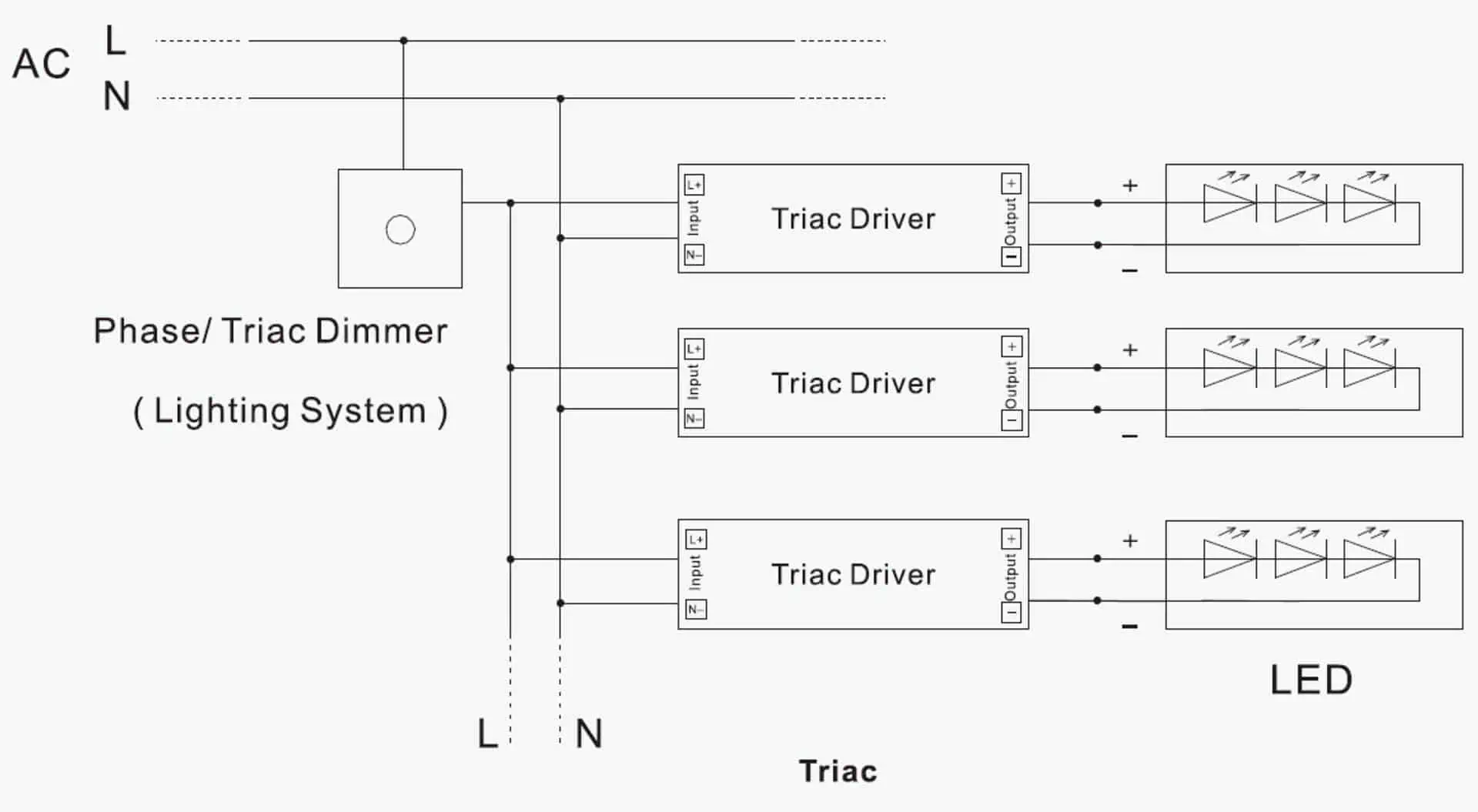
DALI Dimmable LED Driver Connection Diagram
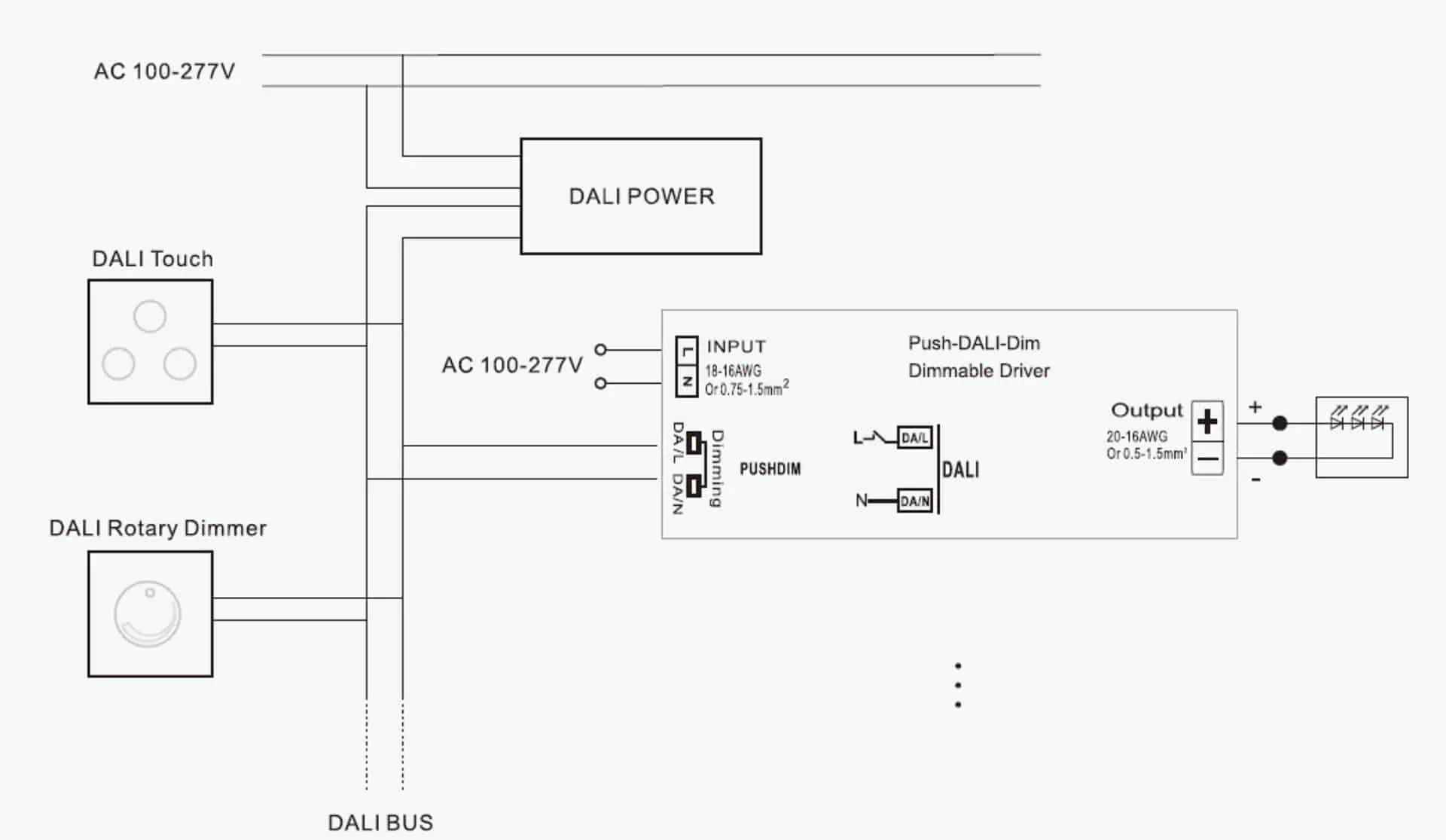
Wiring Single Color LED Strip Lights With LED Controllers
In addition, the single-color LED strip light can also be connected to a controller to adjust the brightness. If you need more information, please read the following articles:
Without PWM Amplifier
When you connect a small number of LED strips with an LED controller, an LED amplifier is not necessary.
With PWM Amplifier
For large lighting projects, many LED strips are required. LED amplifiers are needed when many LED strips are connected to the controller.
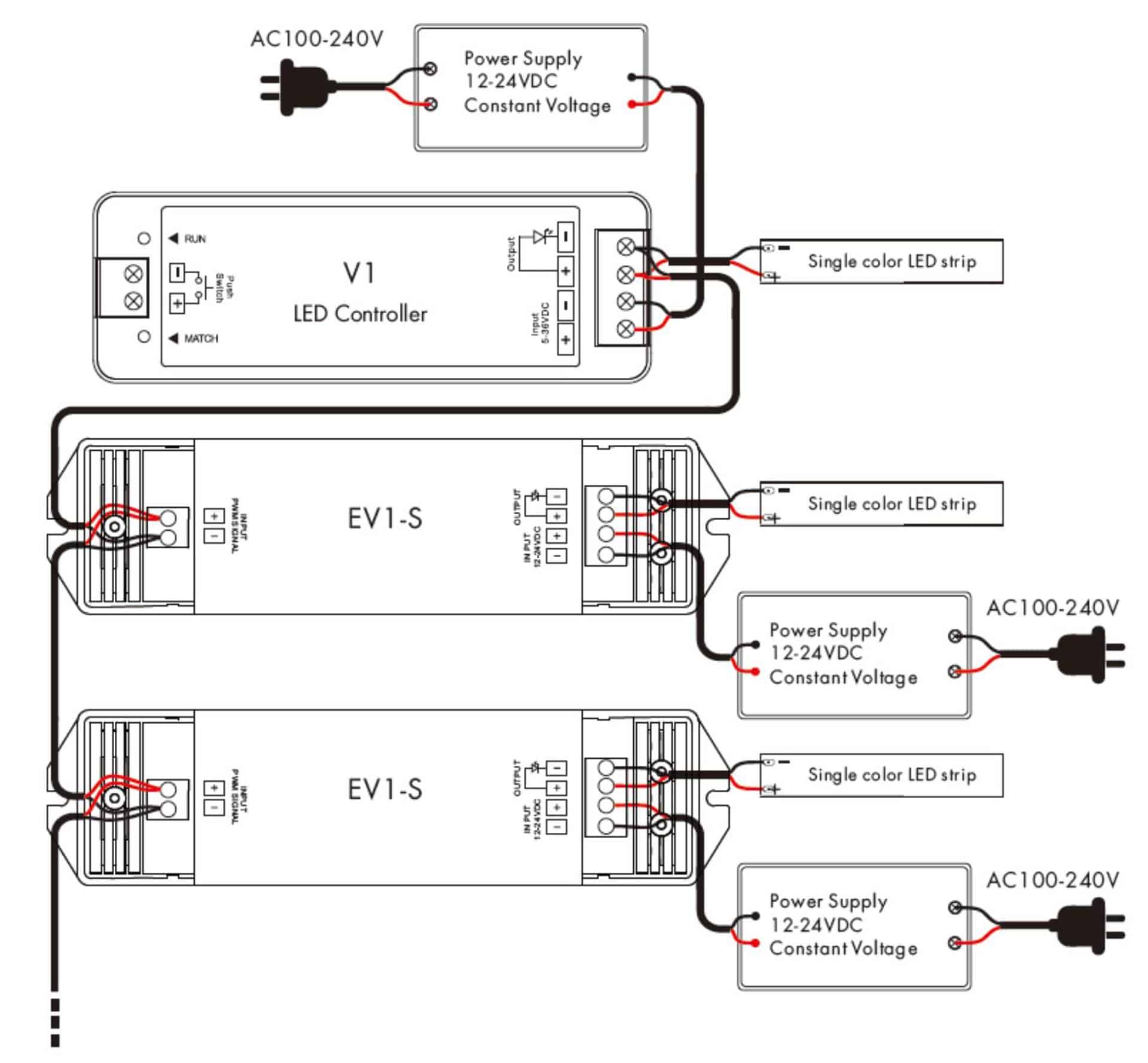
Wiring Single Color LED Strip Lights With DMX512 Decoder
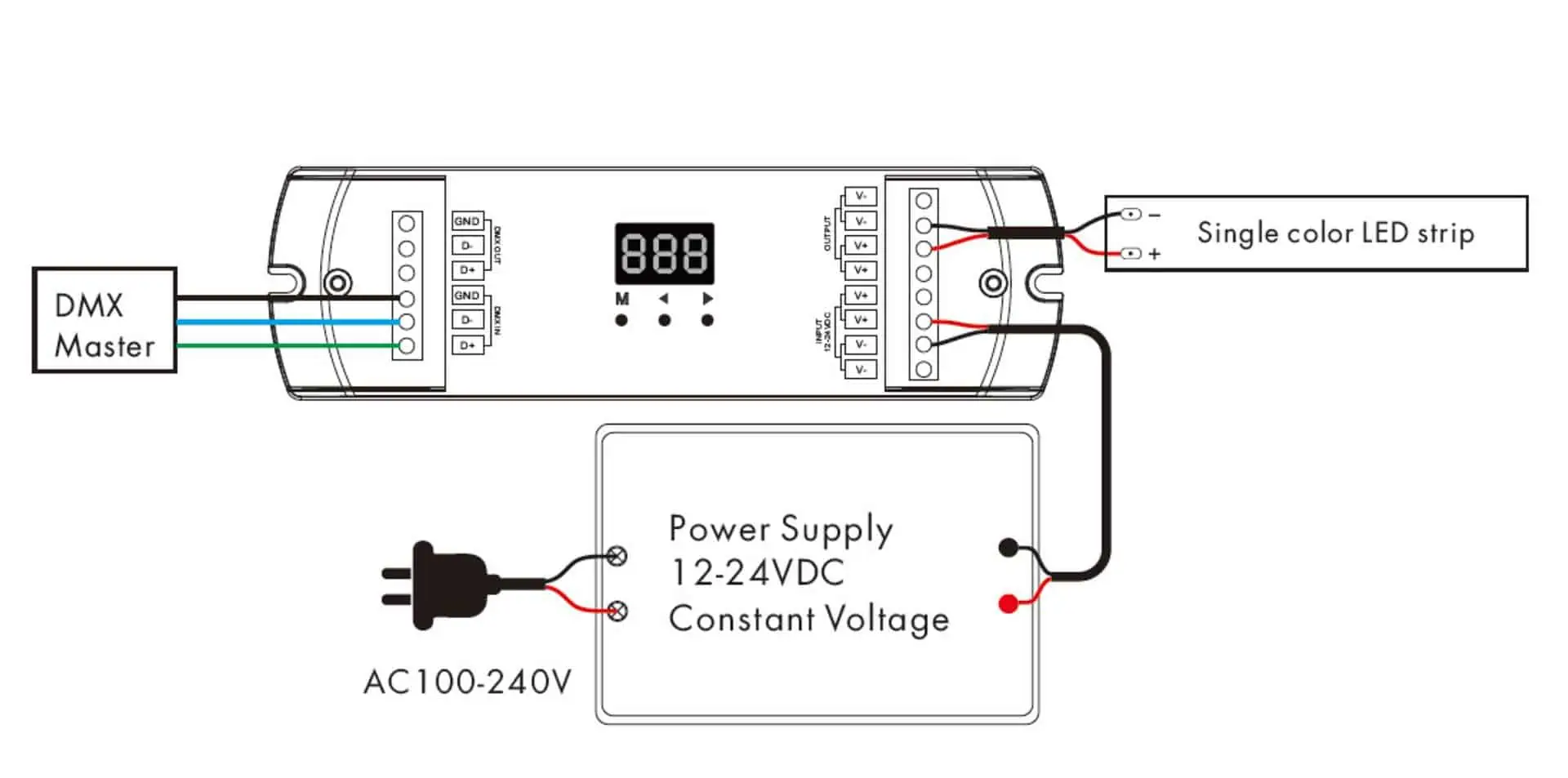
How to Wire Tunable White LED Strip Lights
Tunable white LED strip light, also called CCT adjustable LED strip light, usually has three wires and two different color temperature LEDs. You can adjust the brightness of these two different CCT LEDs to change the mixed CCT. If you need more information, please read the following articles:
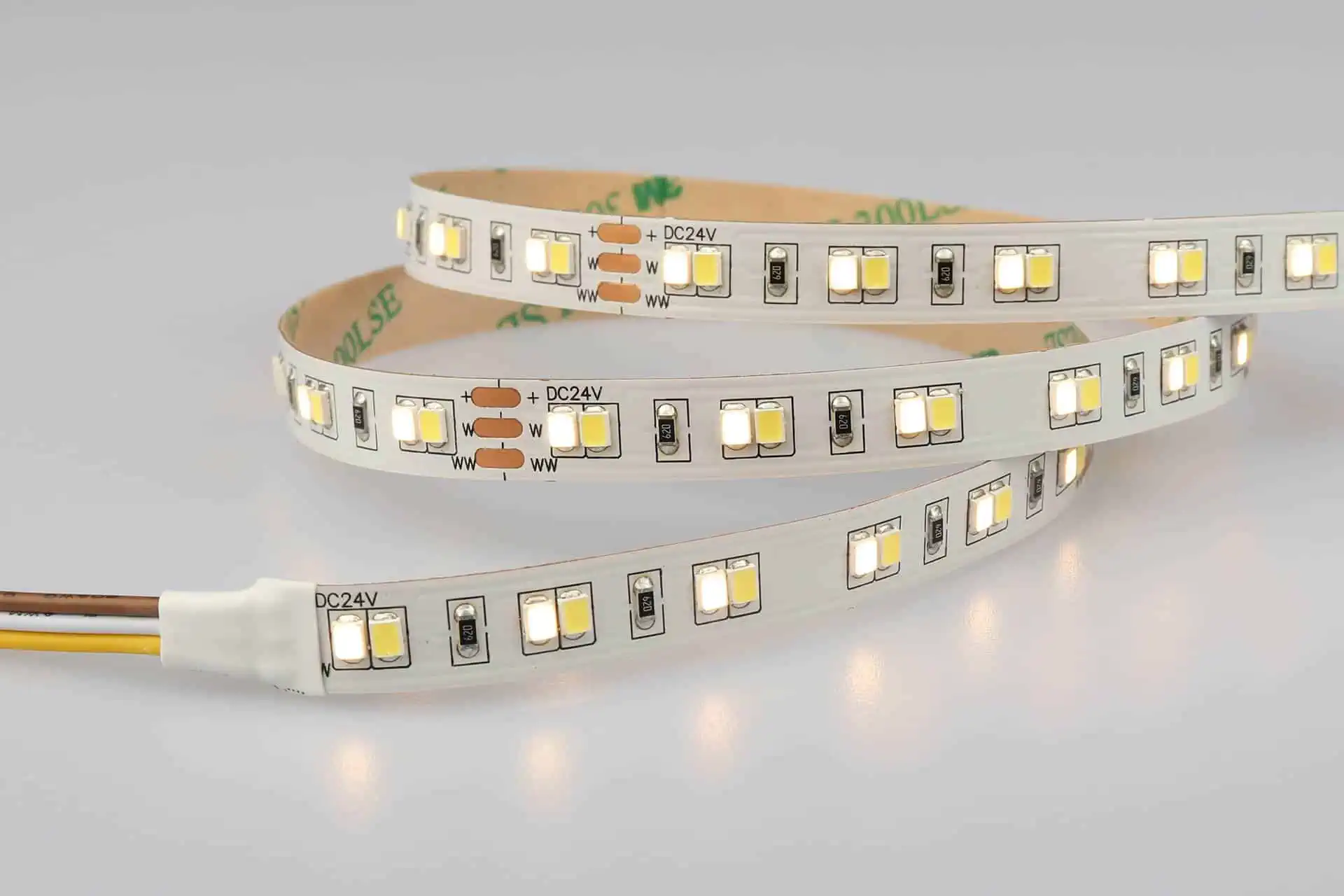
Wiring Tunable White LED Strip Lights With Dimmable LED Drivers
In most cases, dimmable power supplies can only be used to adjust the brightness of single-color LED strips.
However, DALI adds the DT8 protocol to support tunable white, RGB, RGBW, and RGBCCT LED strip lights.
DALI DT8 Tunable White LED Driver
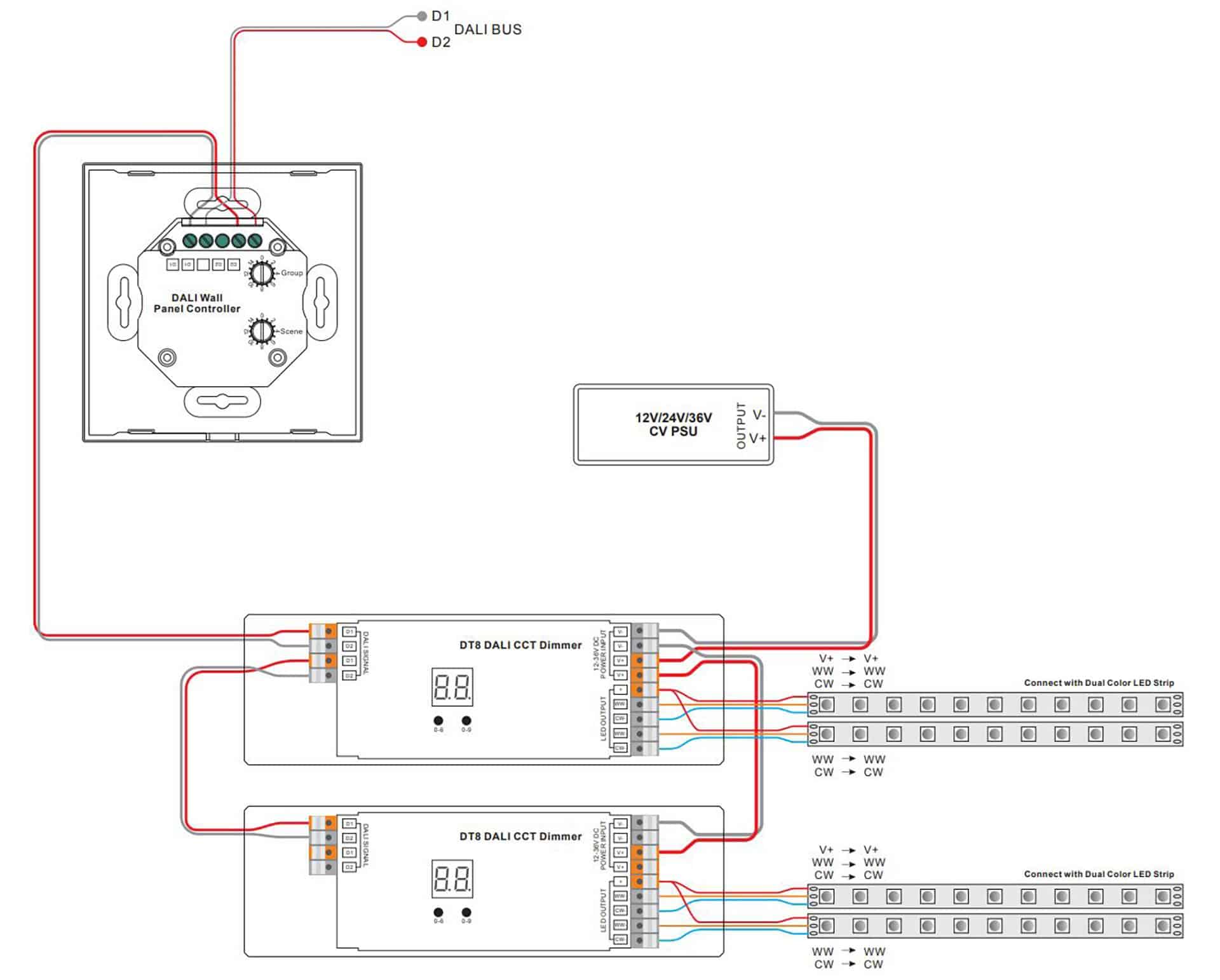
Wiring Tunable White LED Strip Lights With LED Controllers
Only a tunable white LED controller is required for a small number of adjustable color temperature LED strips. If the number is large, then a PWM amplifier is needed.
Without PWM Amplifier
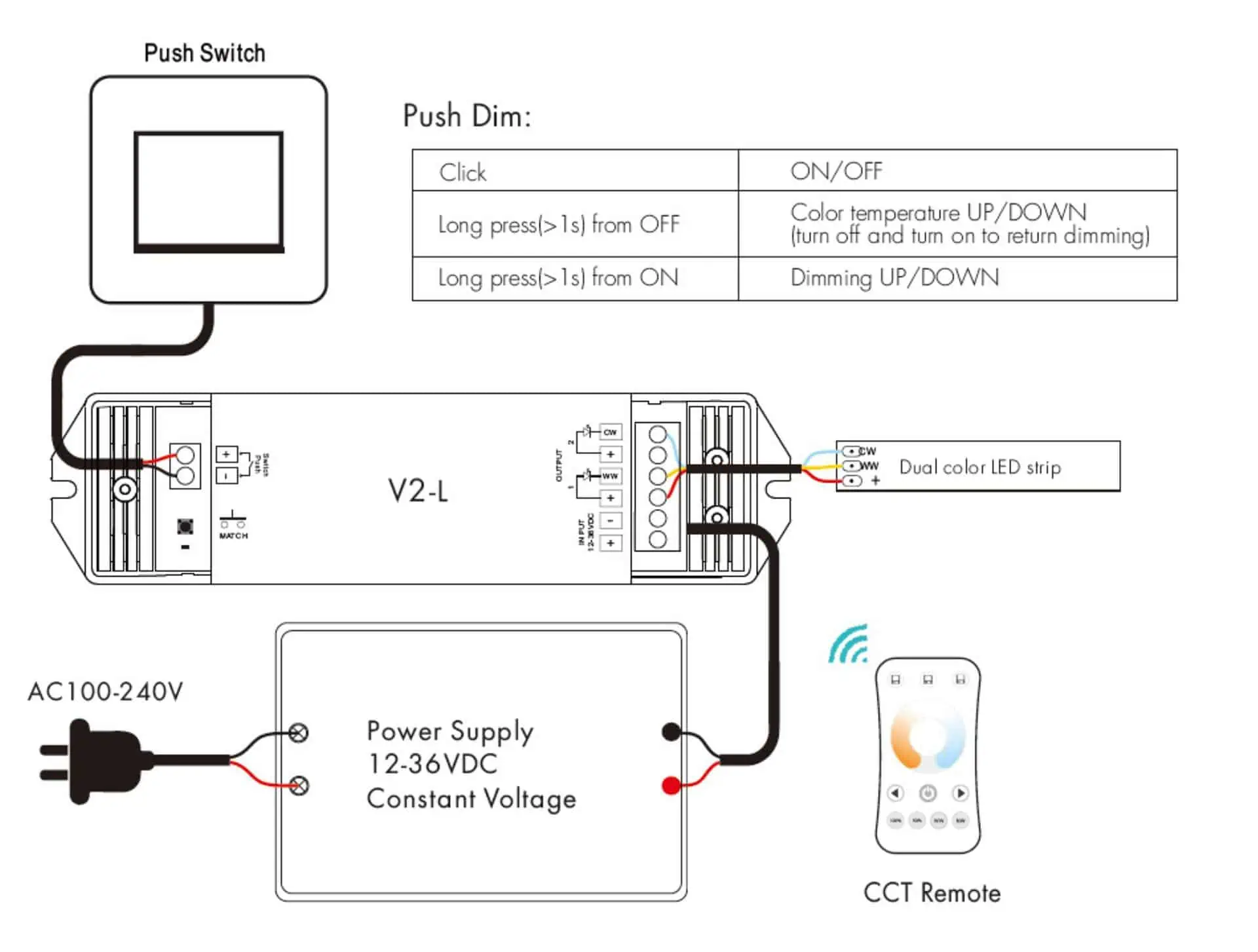
With PWM Amplifier
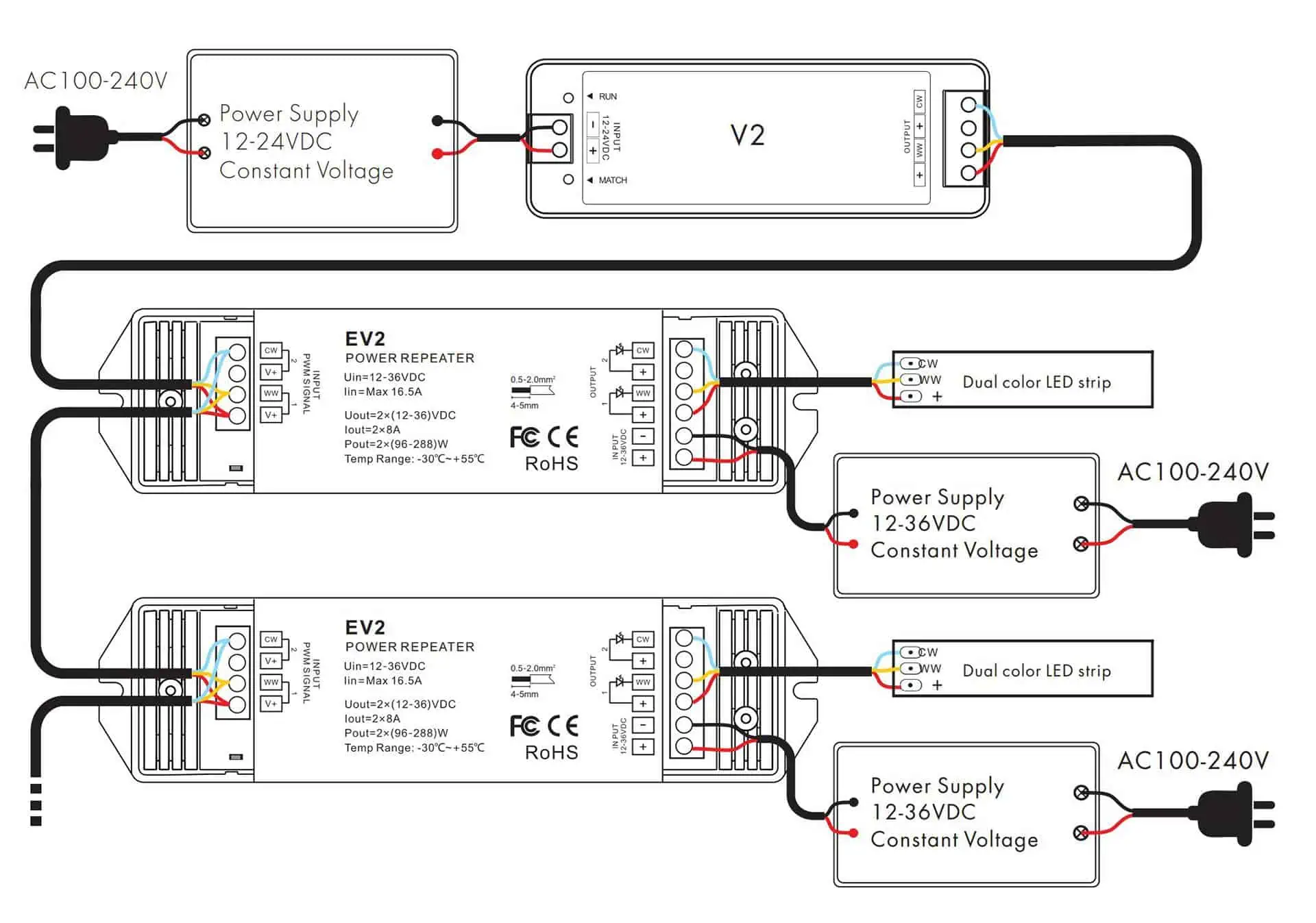
Wiring Tunable White LED Strip Lights With DMX512 Decoder
Generally, there is no dedicated DMX512 decoder (2 channels output) for adjustable color temperature LED strips.
But we can use the 3-channel or 4-channel output DMX512 decoder to control the adjustable color temperature LED strip.
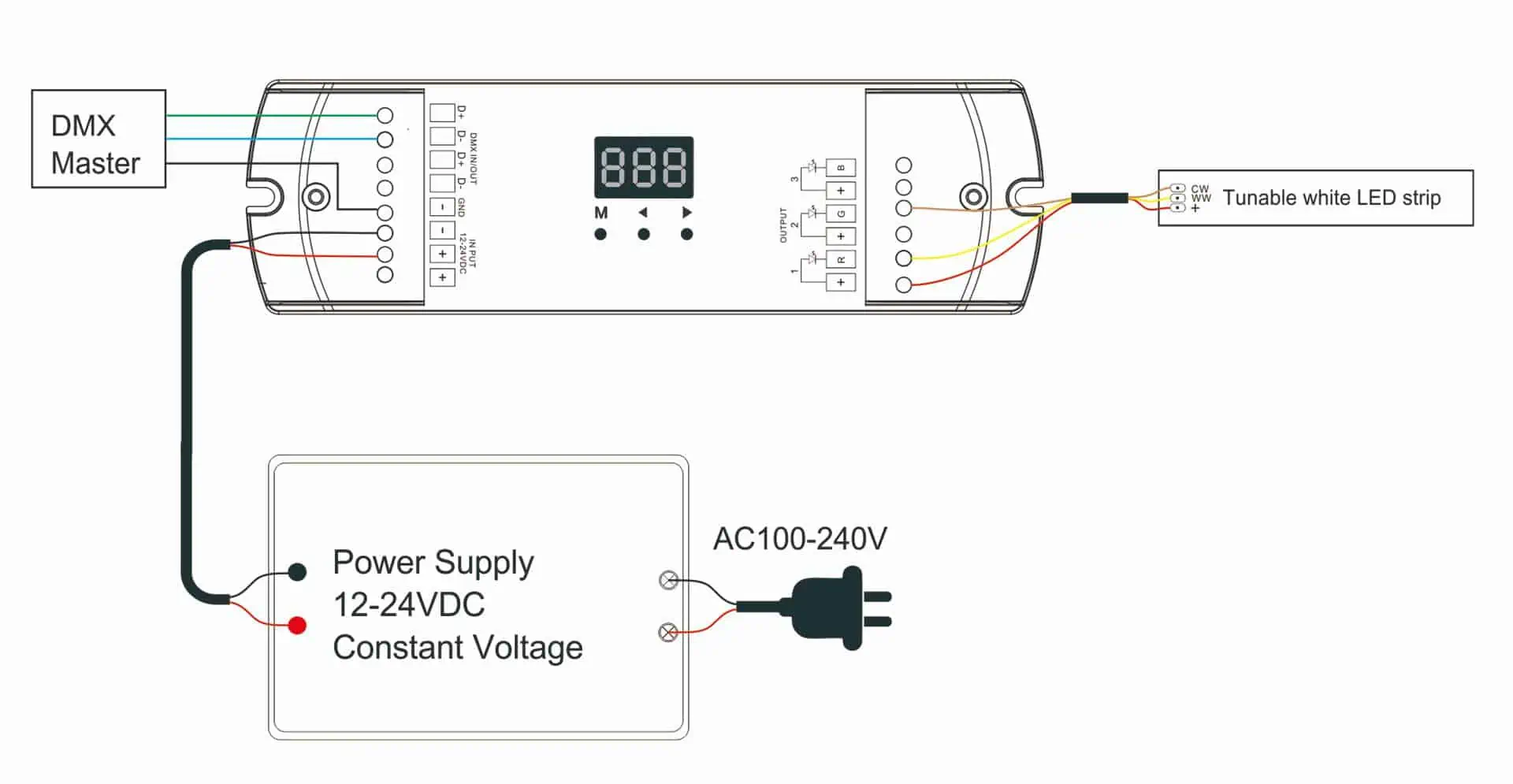
Two Wires Tunable White LED Strip Lights
There is also a 2-wire adjustable color temperature LED strip.
There is also a 2-wire adjustable color temperature LED strip. The 2-wire color temperature LED strip can be made narrower for some narrow places.
For more details about 2-wire adjustable color temperature LED strip, please click here.
2-wire tunable LED strip requires the unique tunable white LED controller.
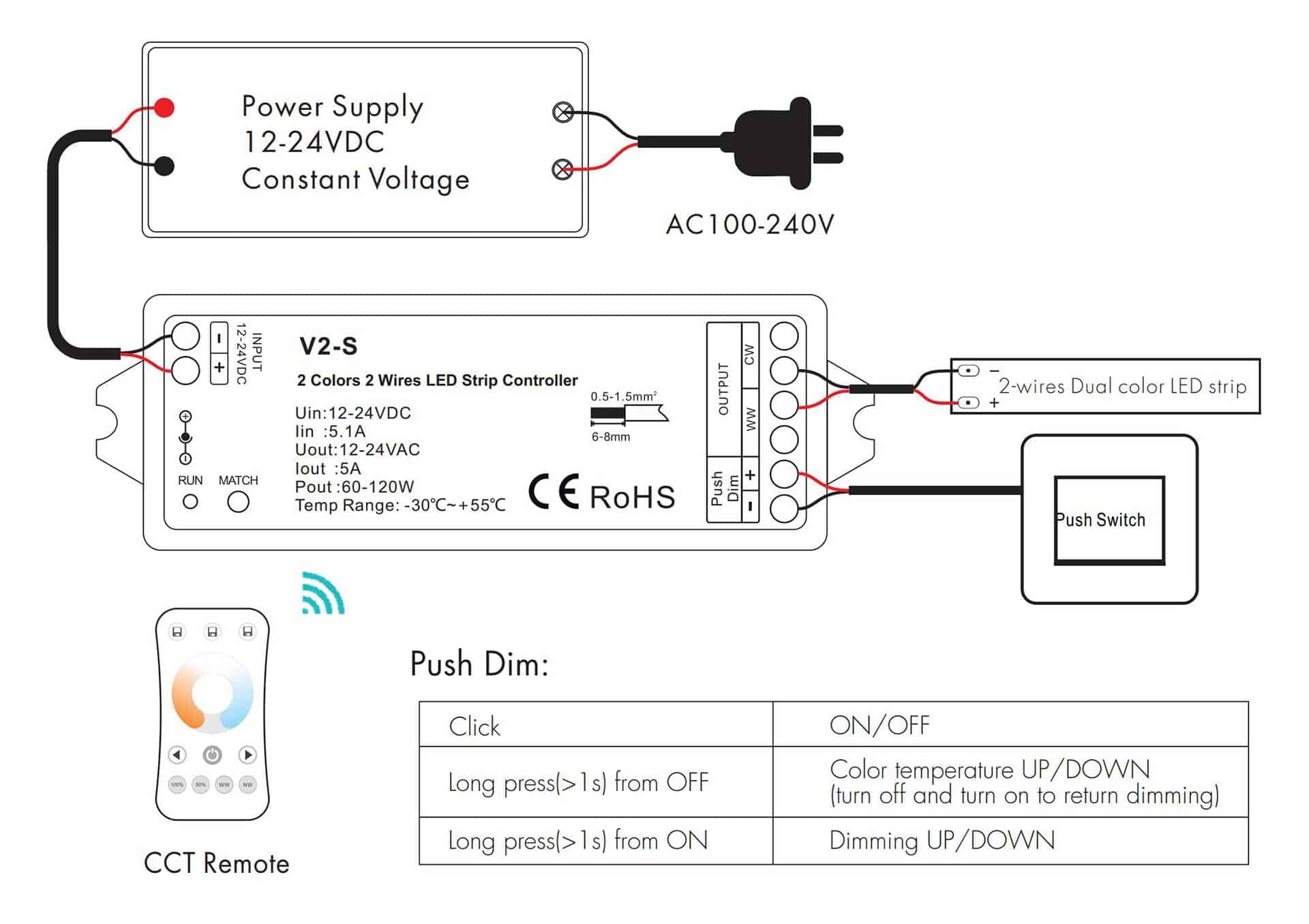
Two Wires Dim To Warm LED Strip Lights
Dim to Warm LED strip lights are designed to mimic the behavior of incandescent lighting, where the color temperature becomes warmer as the light is dimmed. This type of LED strip typically has two wires and adjusts its color temperature automatically as the brightness is lowered.
Dim to Warm vs. Tunable White LED Strip
| Color Temperature Range | Automatically warms when dimmed (e.g., 3000K to 1800K) | Manually adjustable between two set CCTs (e.g., 2700K to 6000K) |
| Control | Simple dimming control with standard dimmers | Requires a controller for adjusting CCT |
| Wiring | Two wires | Typically three wires |
| Application | Ideal for creating cozy, warm atmospheres | Suitable for dynamic lighting environments needing different CCTs |
If you need more information, please read Dim To Warm – What It Is and How Does It Work? and Tunable White LED Strip VS. Dim To Warm LED Strip.
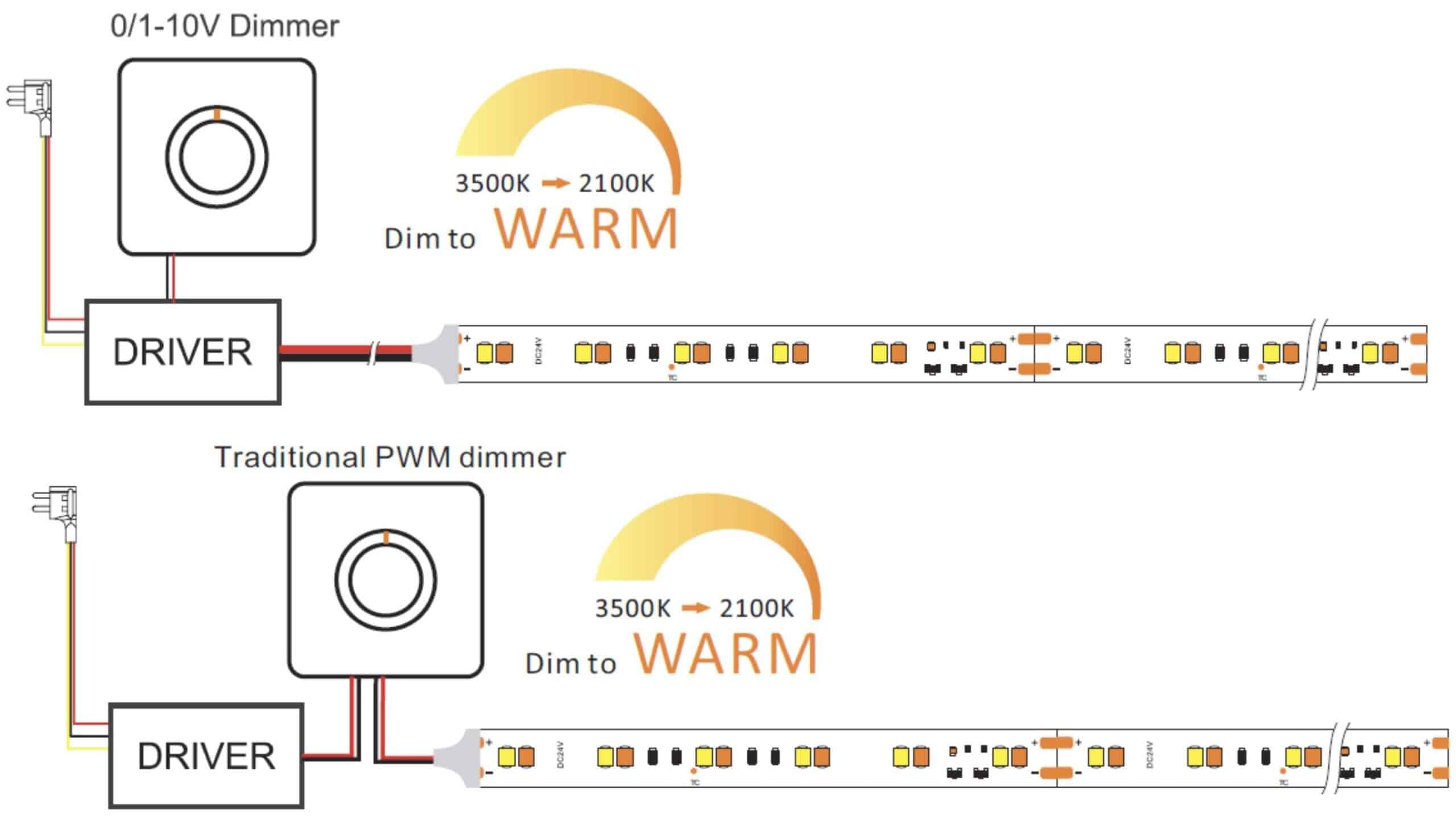
Switch ON/OFF Tunable White LED Strip Lights
Switch ON/OFF Tunable White LED strip lights adjust color temperature by simply toggling a wall switch. This method requires no controllers or receivers, making it easy to operate. The strip offers three color temperatures, changing with each switch cycle, and returns to warm white (2700K) after being off for more than 6 seconds.
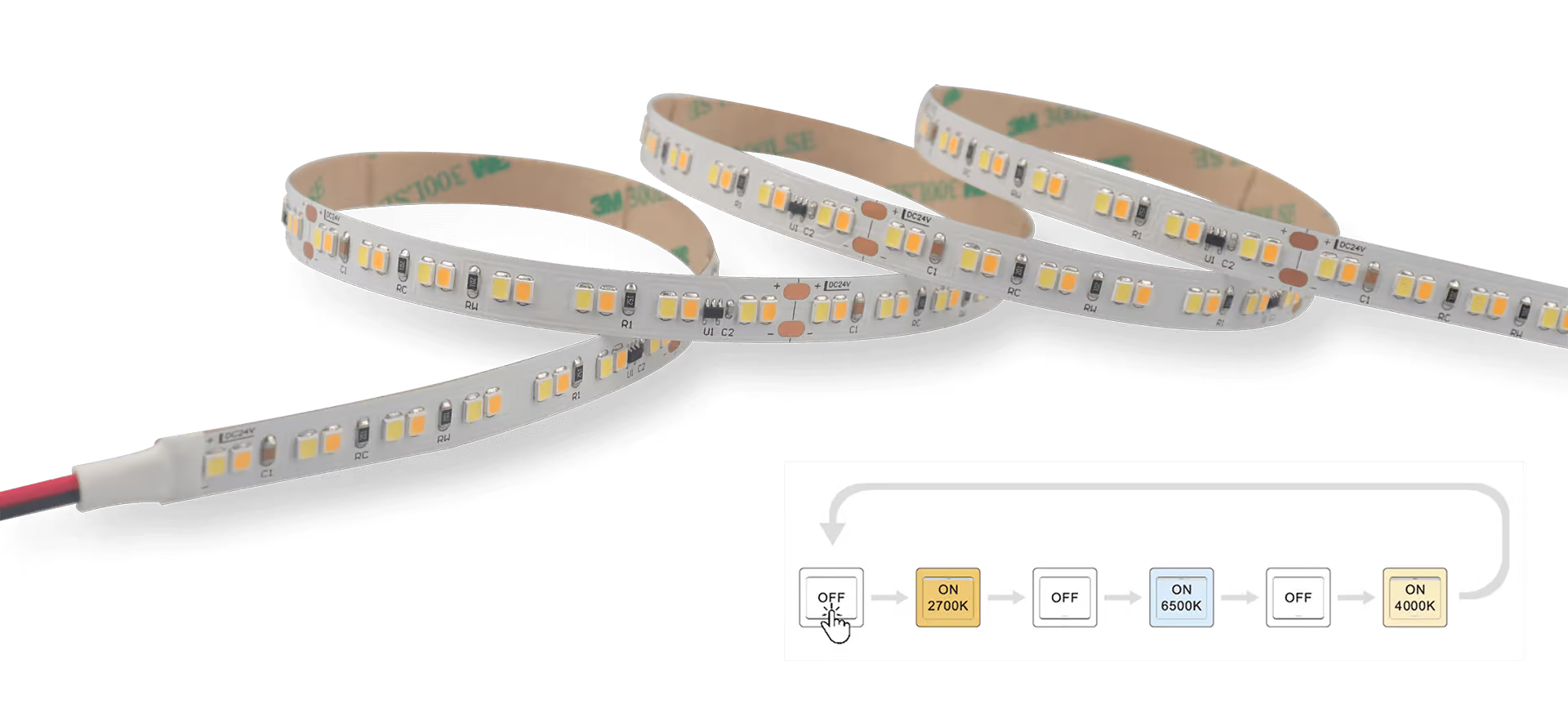

Note: The wall switch must be between the LED power supply input wire and the high voltage AC main wire.
How to Wire RGB LED Strip Lights
RGB LED strip has four wires, which are common anode, R, G, and B.
RGB LED strips are mainly used with LED controllers but can also be used with DALI DT8 dimmable drivers.
If you need more information, please read:
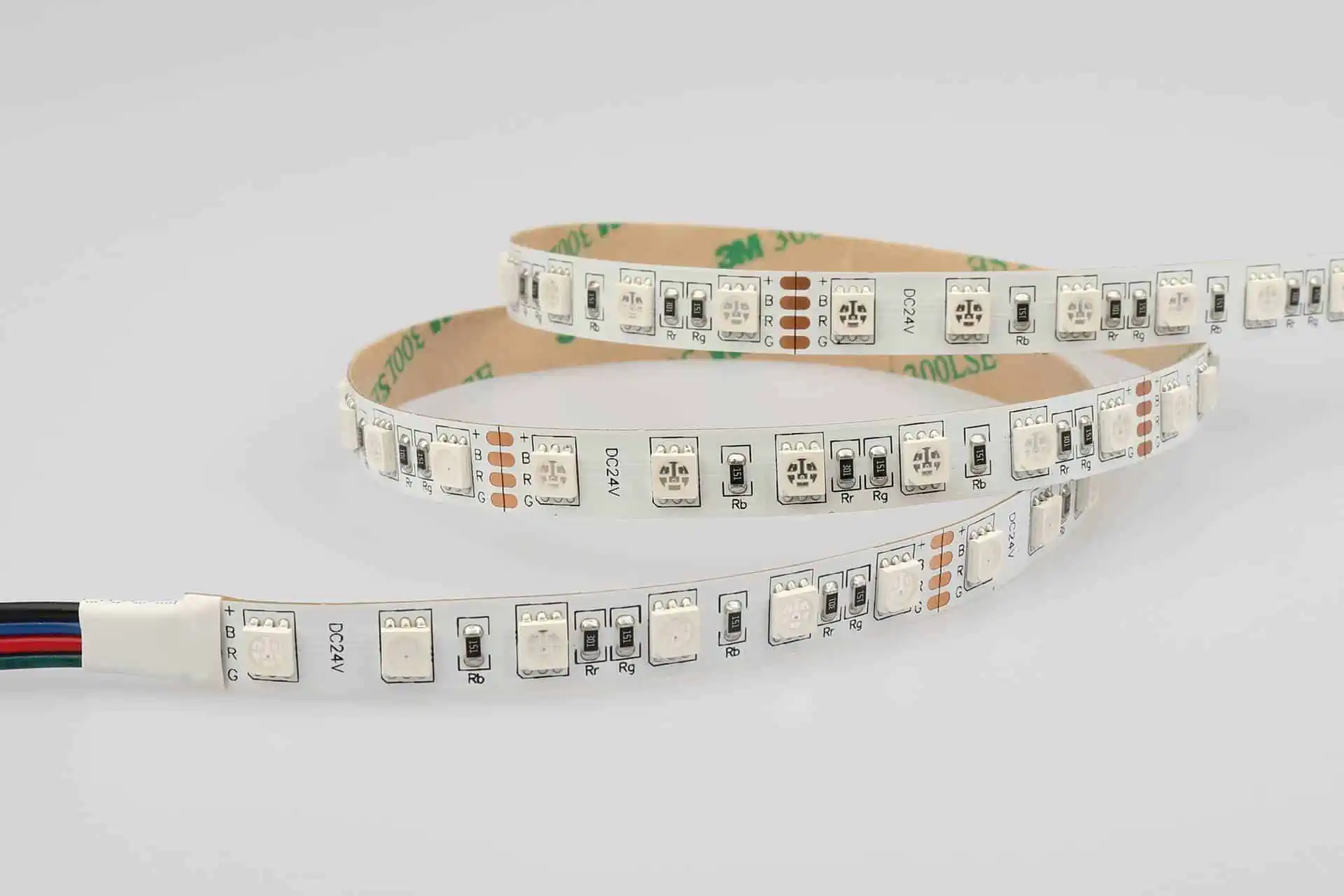
Wiring RGB LED Strip Lights With Dimmable LED Drivers
DALI DT8 RGB LED Driver
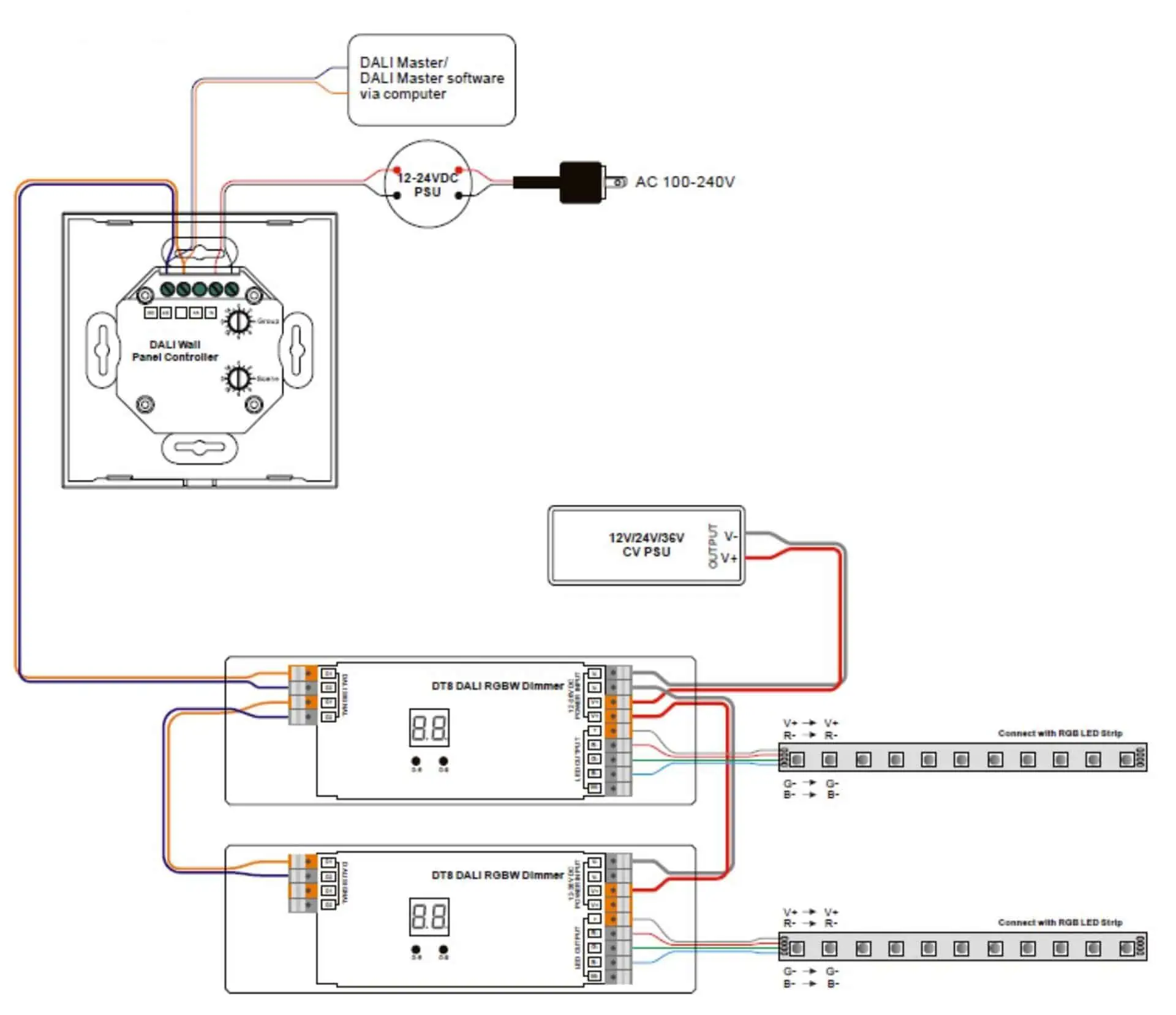
Wiring RGB LED Strip Lights With LED Controllers
Without PWM Amplifier
With PWM Amplifier
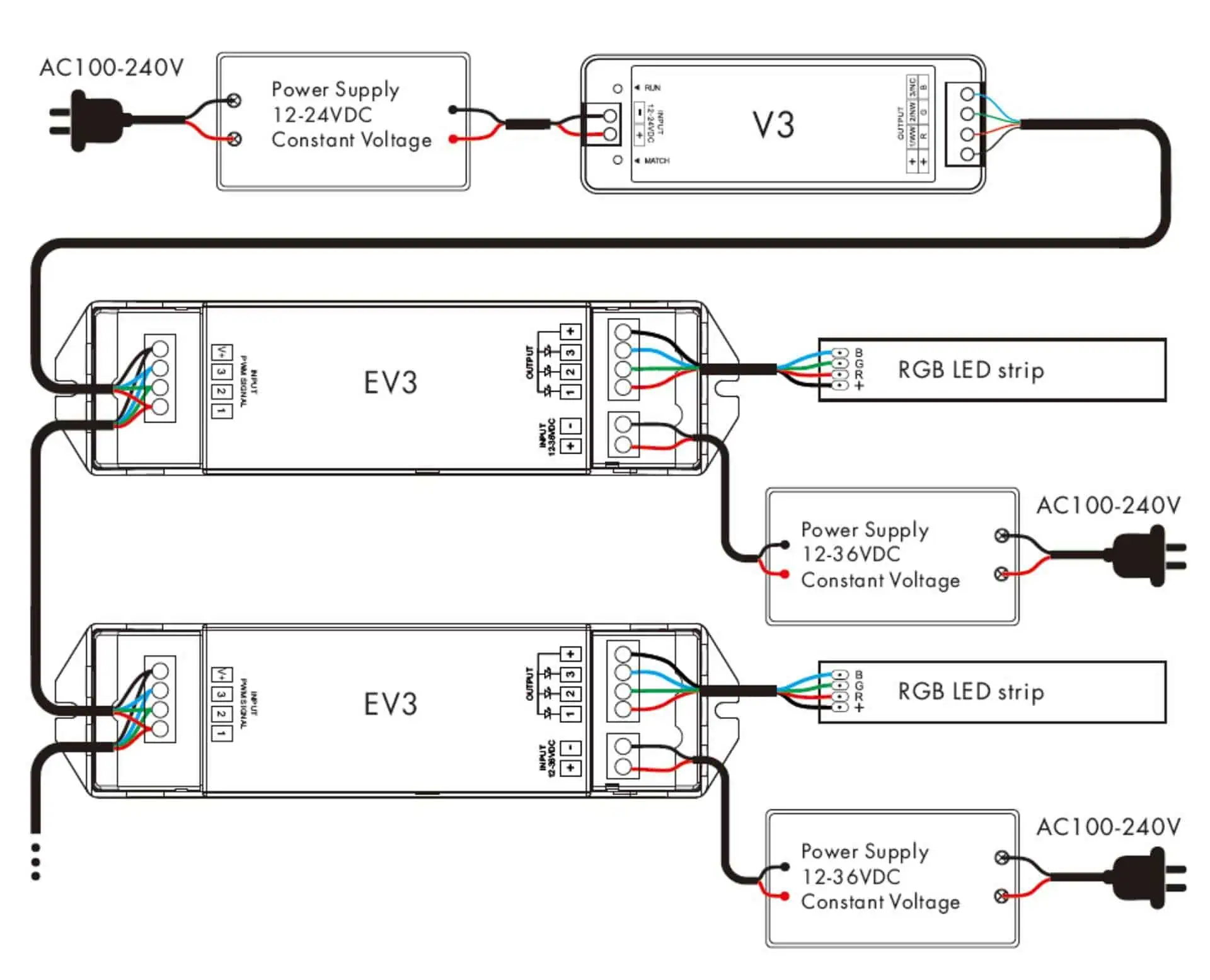
Wiring RGB LED Strip Lights With DMX512 Decoder
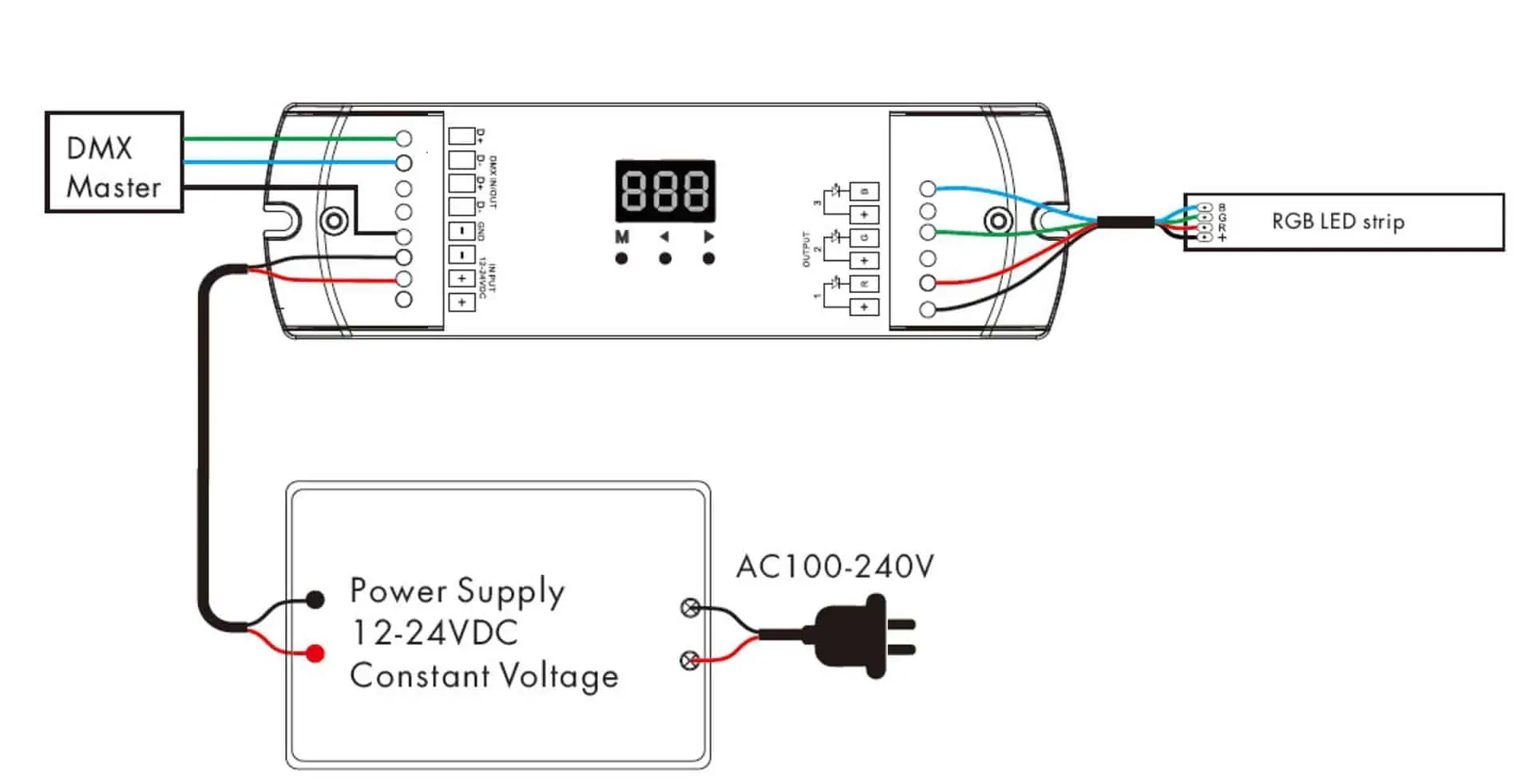
How to Wire RGBW LED Strip Lights
An RGBW LED strip light has four color channels: Red, Green, Blue, and White. This allows for the creation of both vibrant colors and pure white light, offering more versatility than a standard RGB strip.
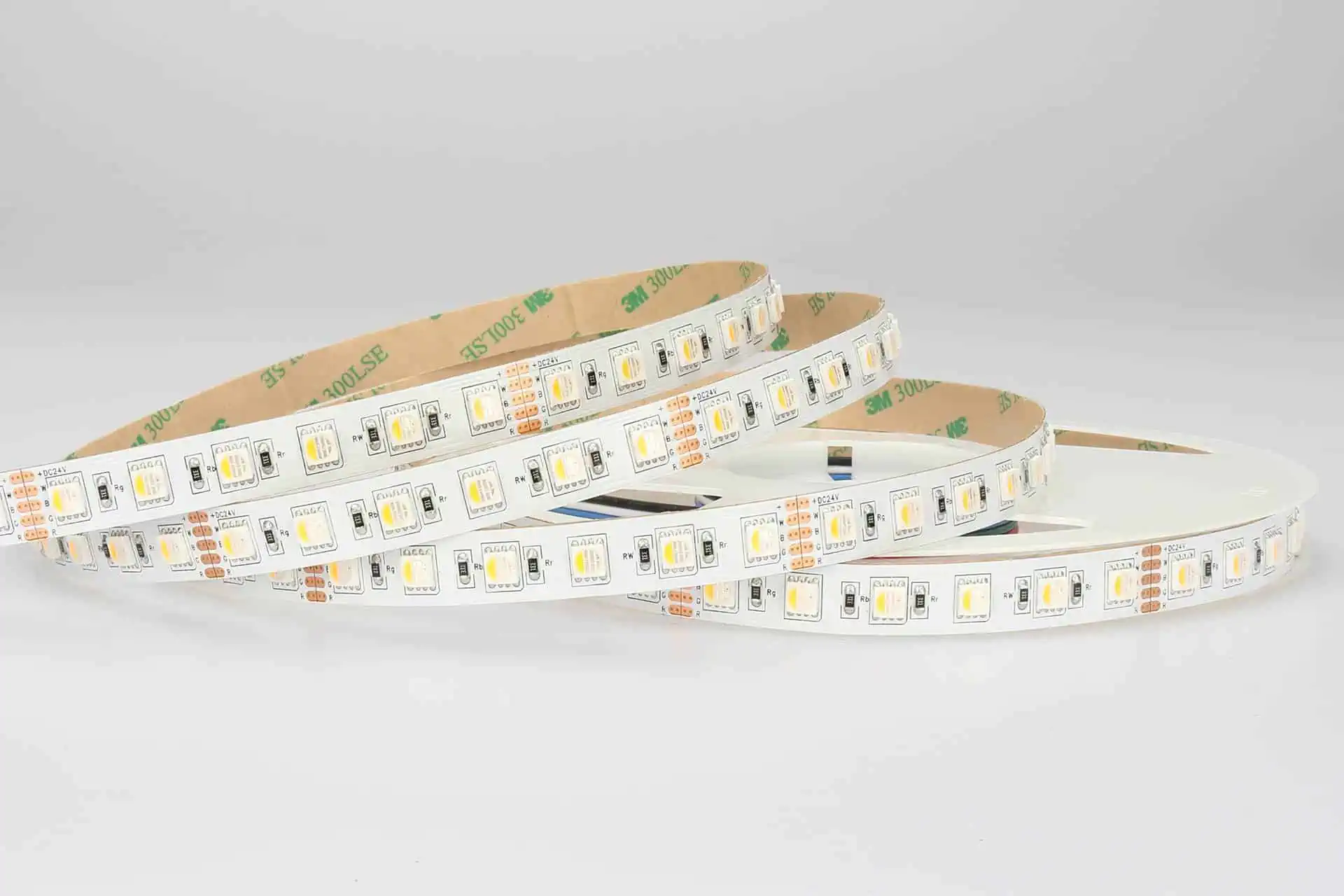
Wiring RGBW LED Strip Lights With Dimmable LED Drivers
DALI DT8 RGBW LED Driver
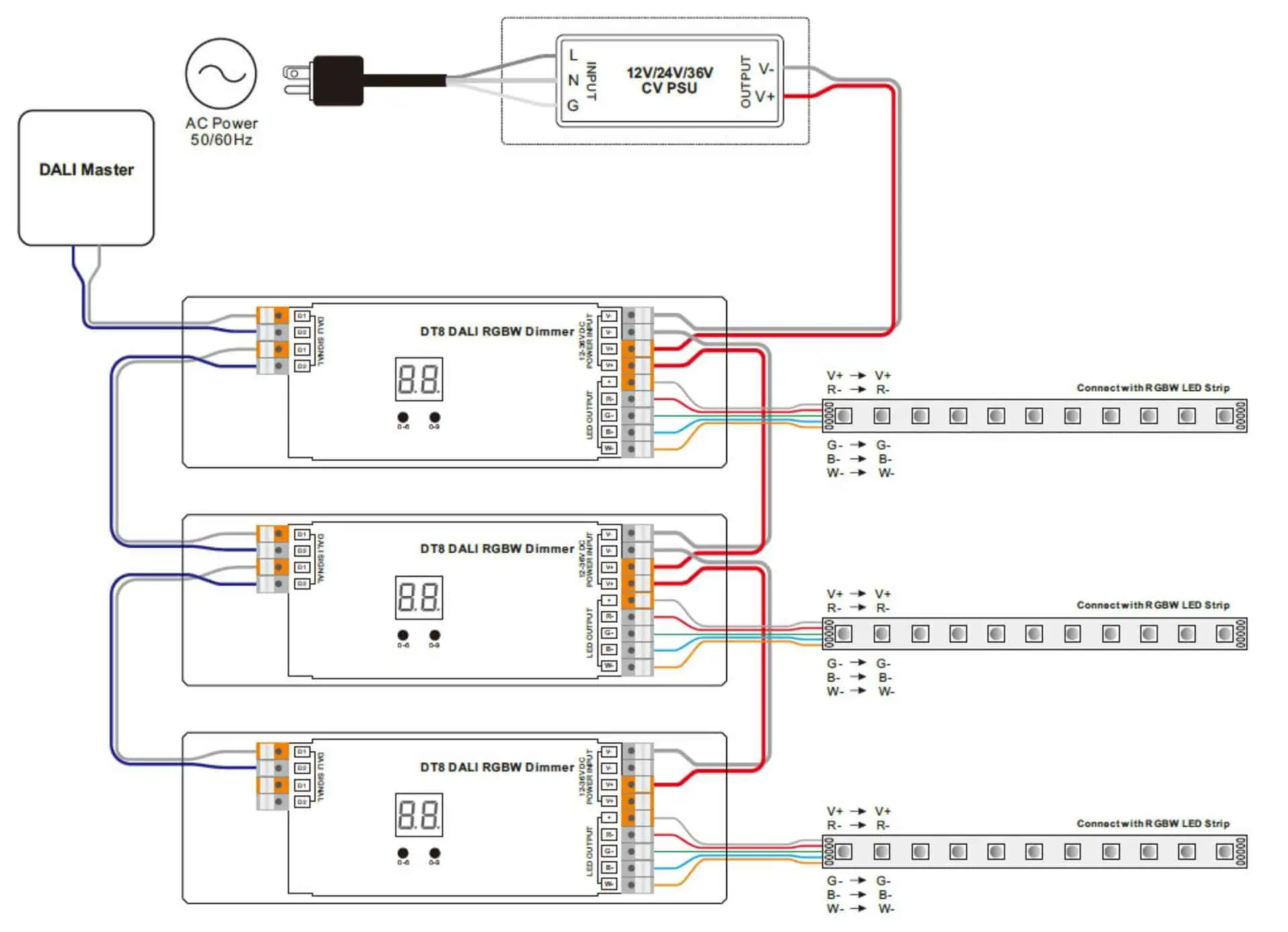
Wiring RGBW LED Strip Lights With LED Controllers
Without PWM Amplifier
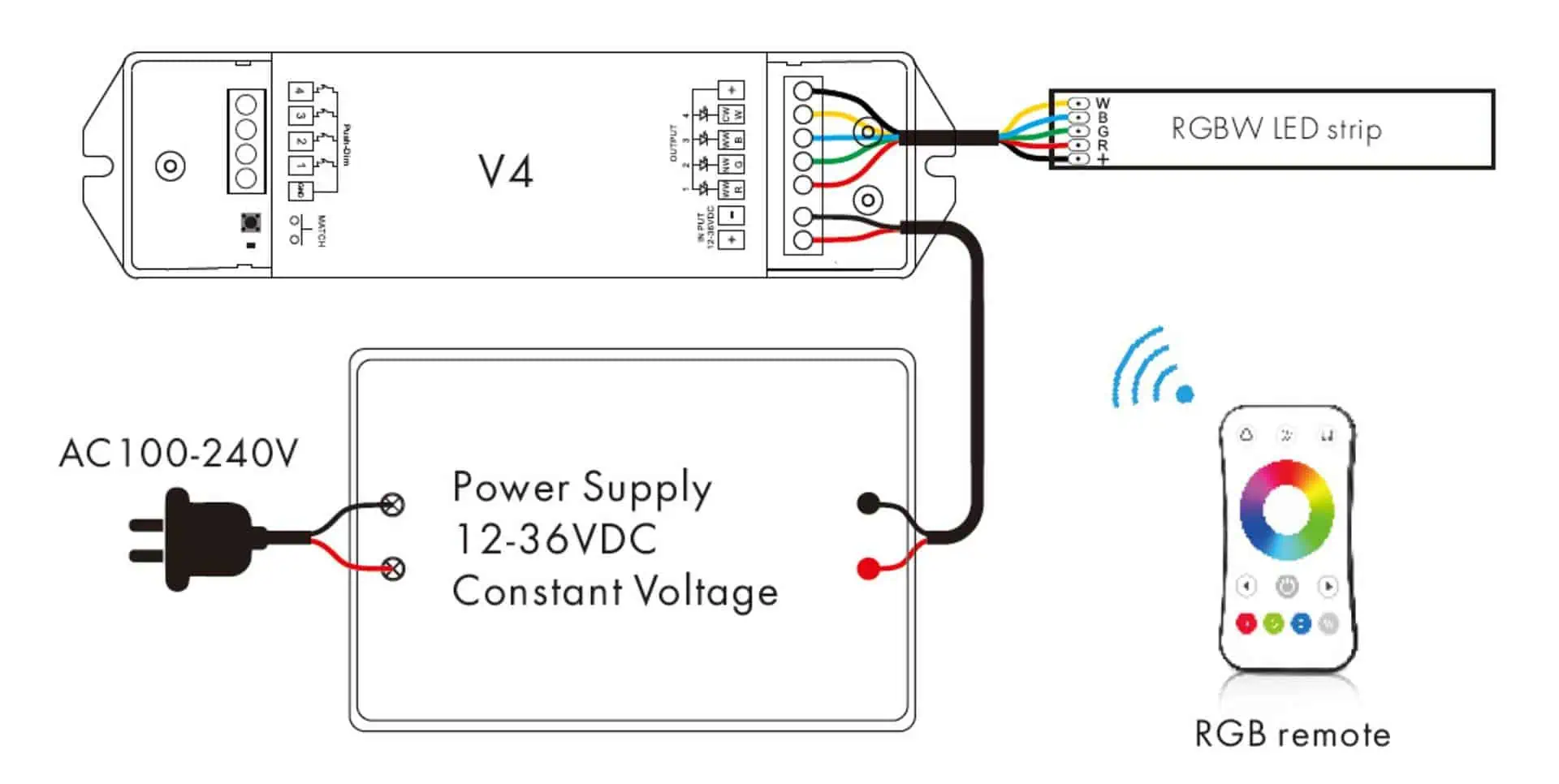
With PWM Amplifier
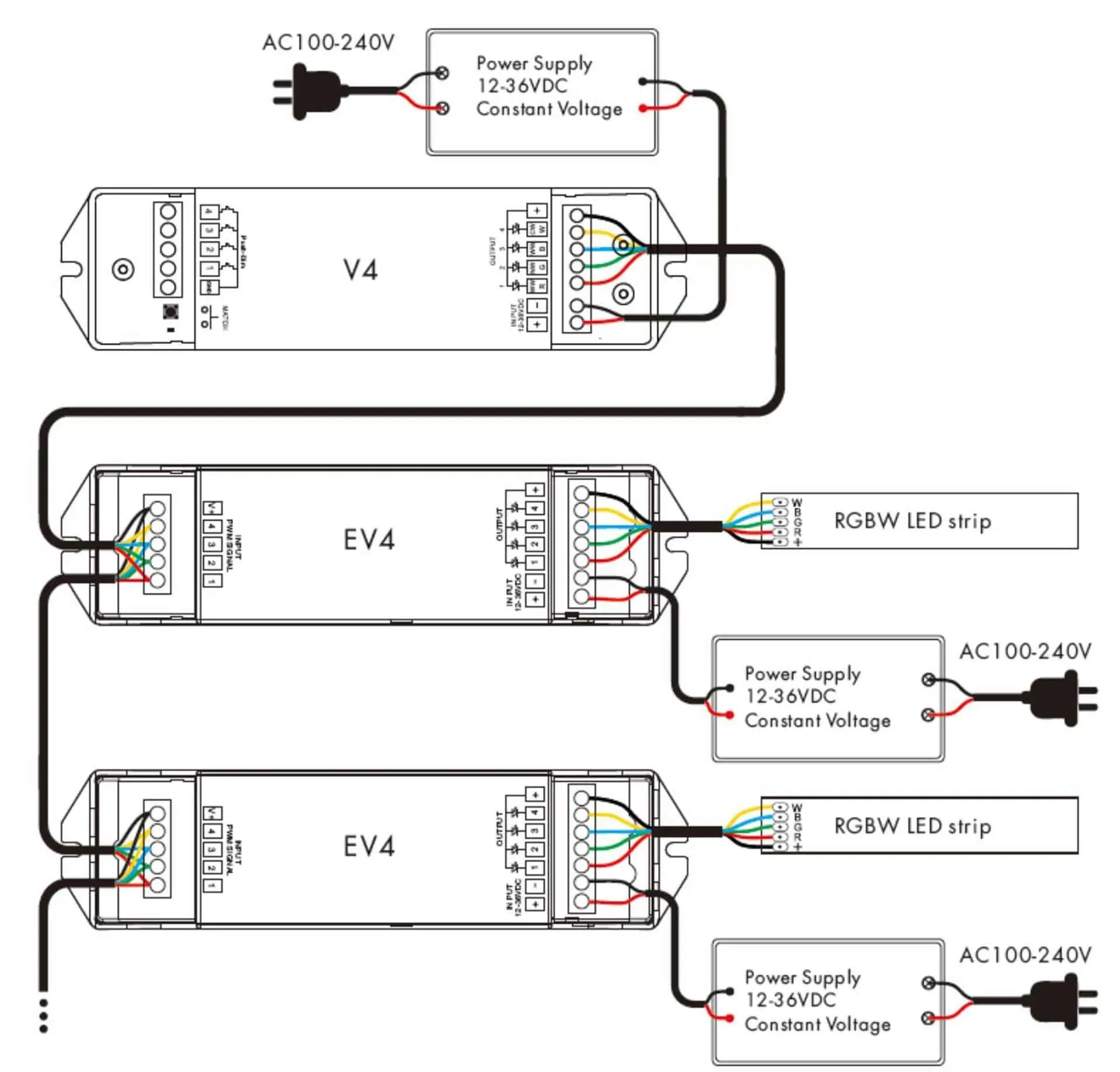
Wiring RGBW LED Strip Lights With DMX512 Decoder
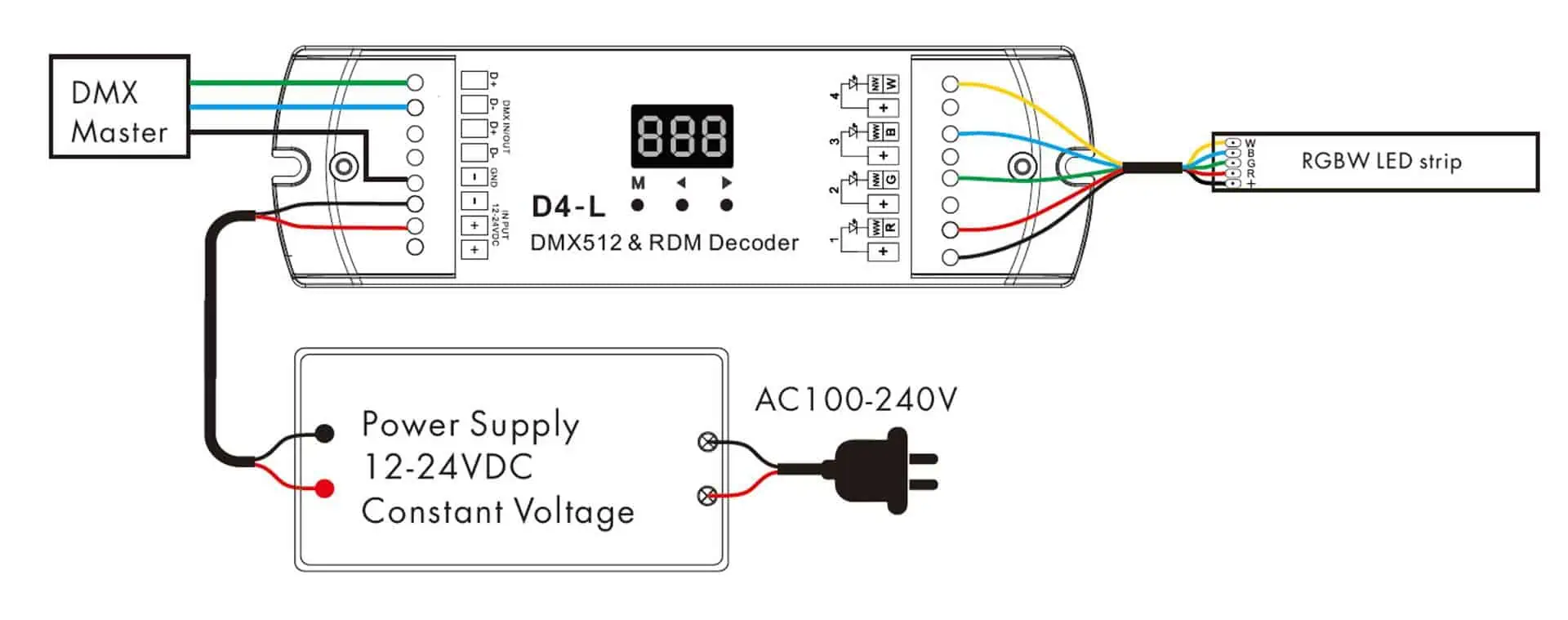
How to Wire RGBCCT LED Strip Lights
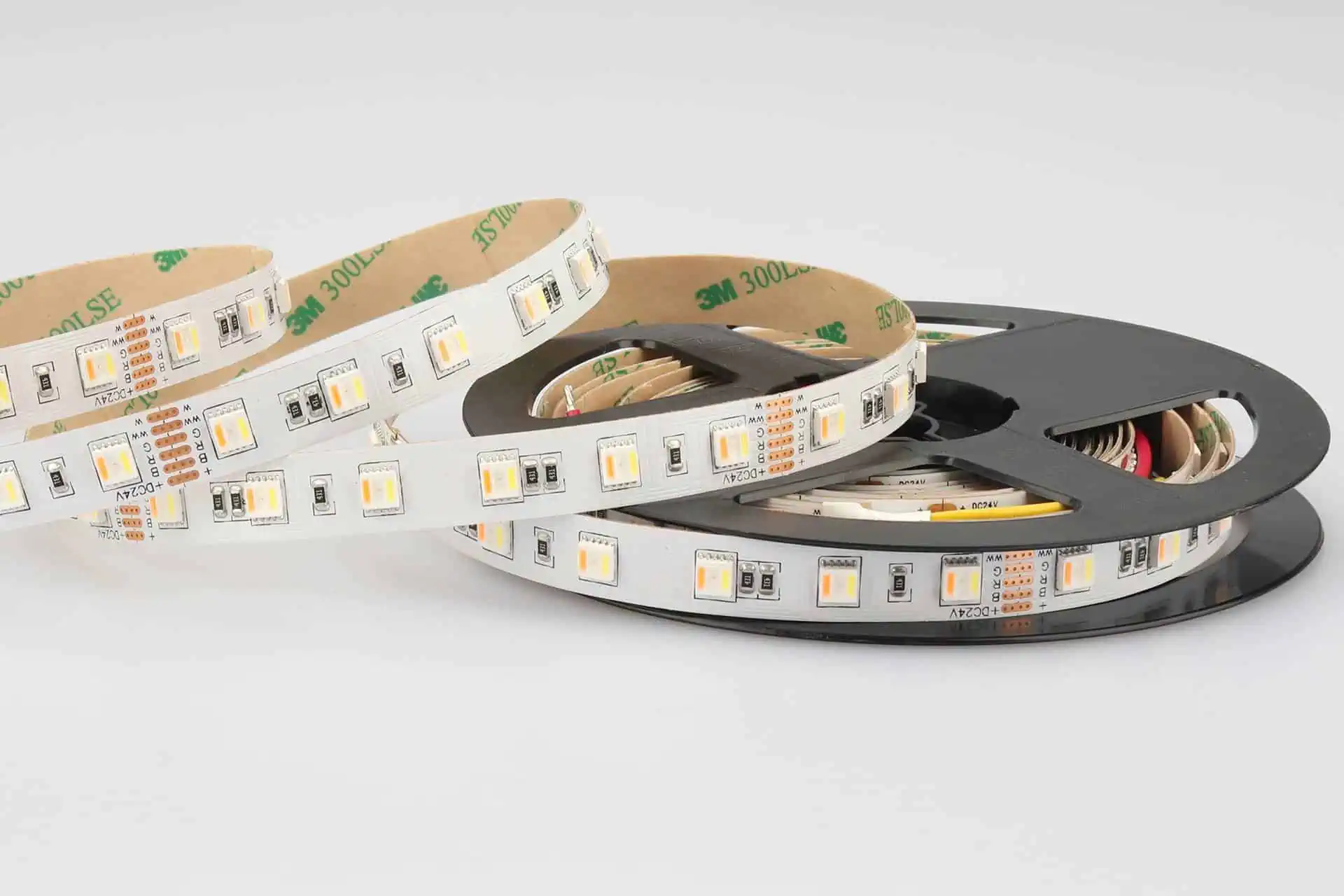
Wiring RGBCCT LED Strip Lights With Dimmable LED Drivers
An RGBCCT LED strip light includes Red, Green, Blue, and dual White channels (Cool White and Warm White). This allows for a full spectrum of colors along with adjustable color temperature, providing both vibrant colors and customizable white lighting.
DALI DT8 RGBCCT LED Driver
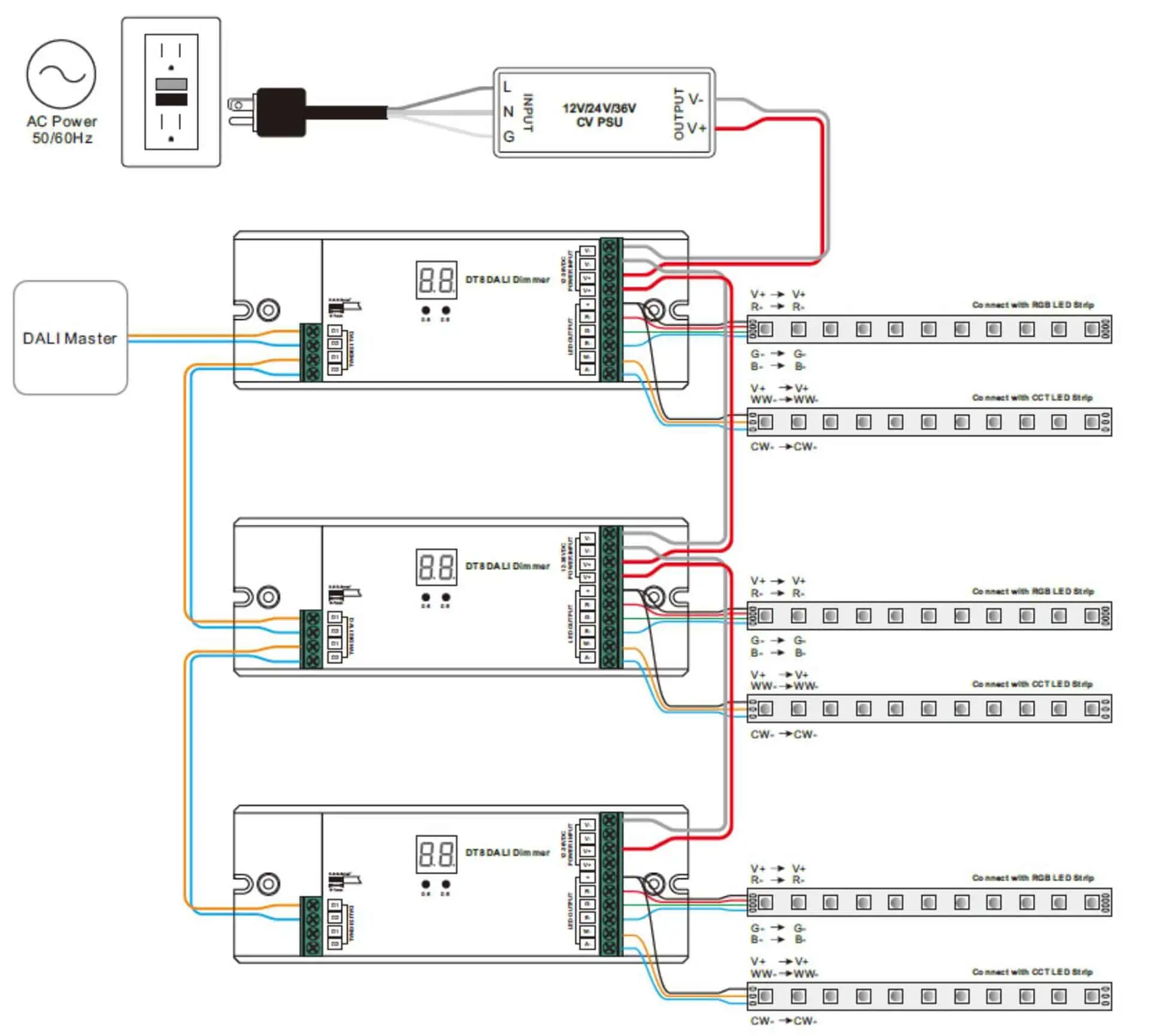
Wiring RGBCCT LED Strip Lights With LED Controllers
Without PWM Amplifier
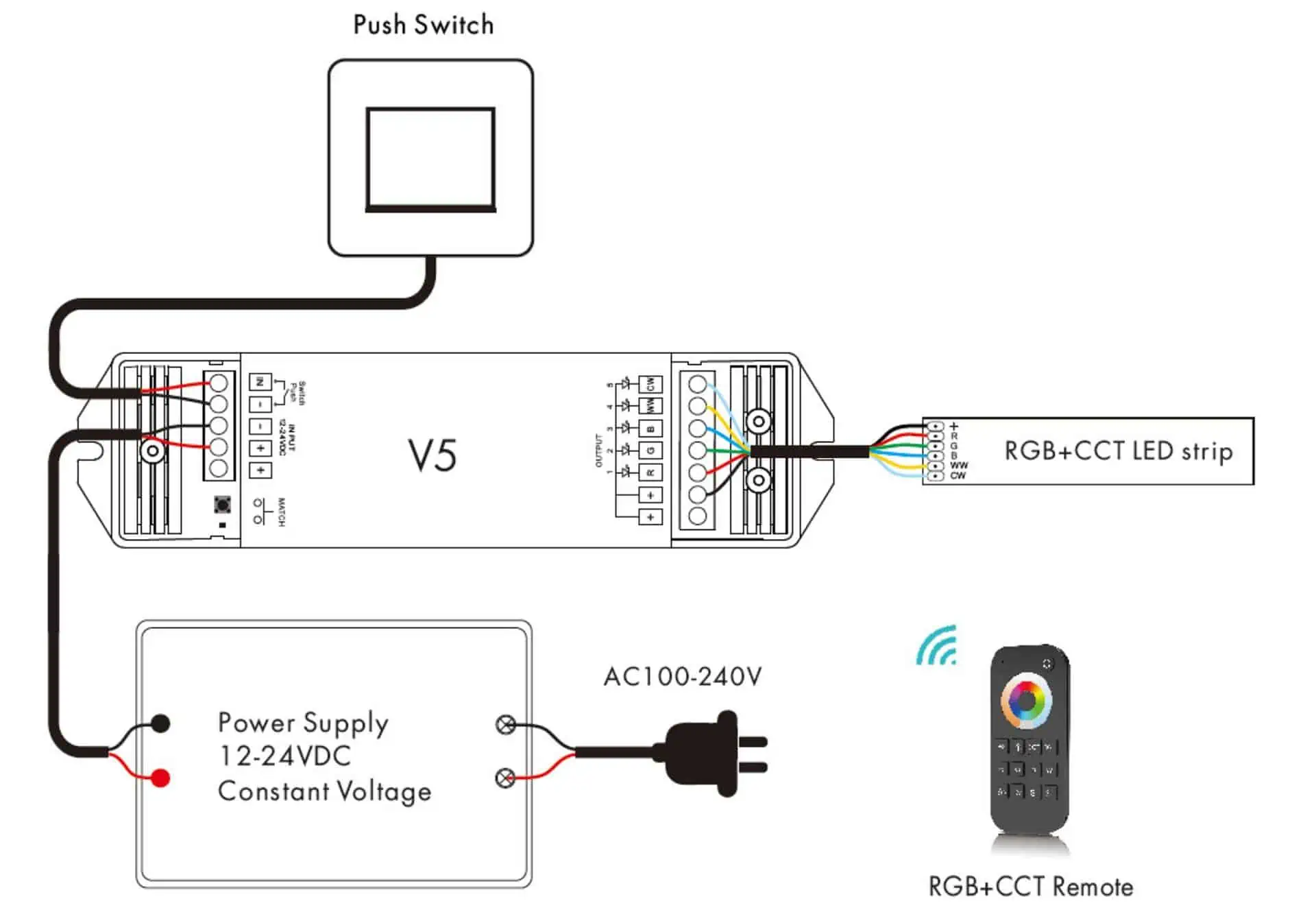
With PWM Amplifier
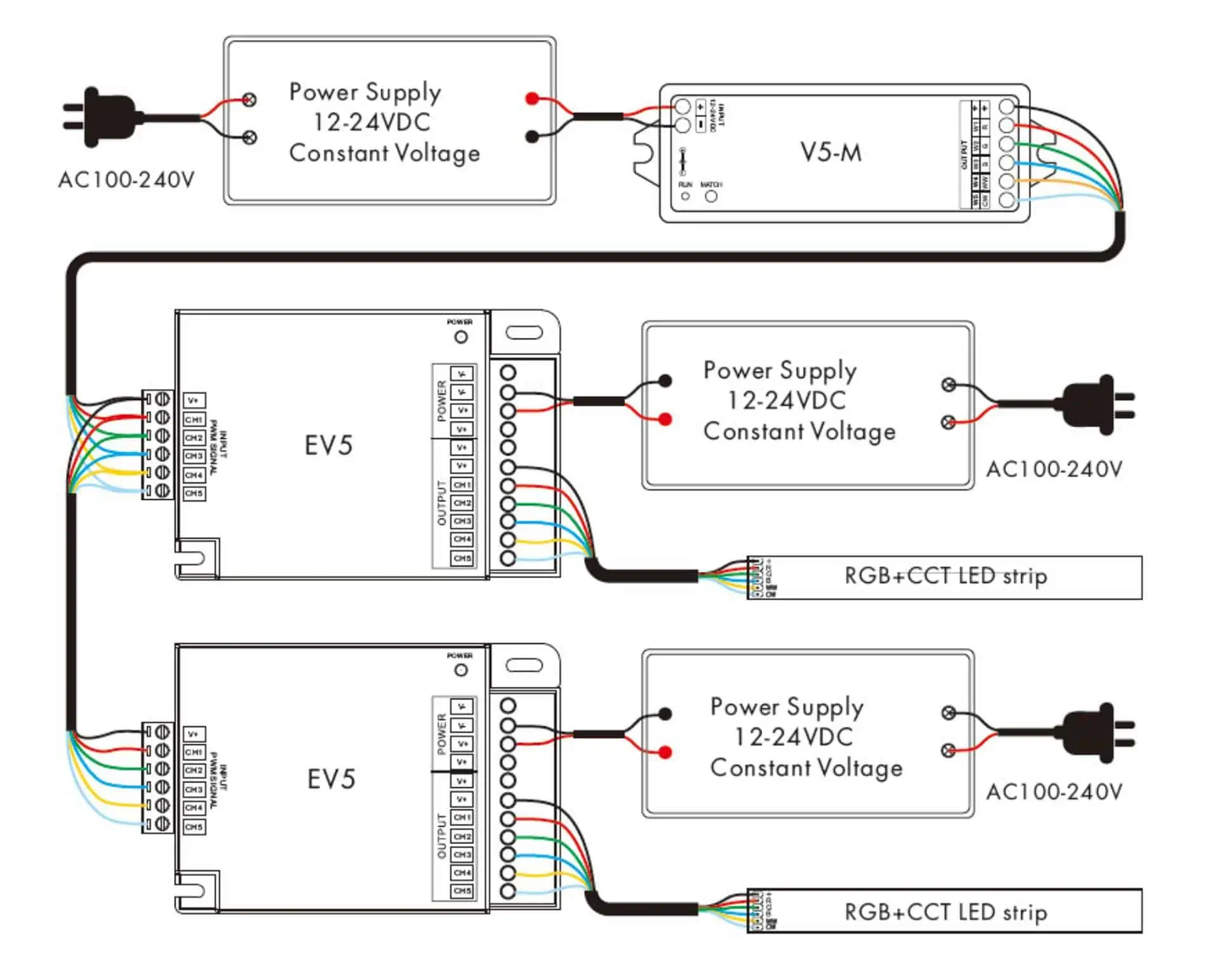
Wiring RGBCCT LED Strip Lights With DMX512 Decoder
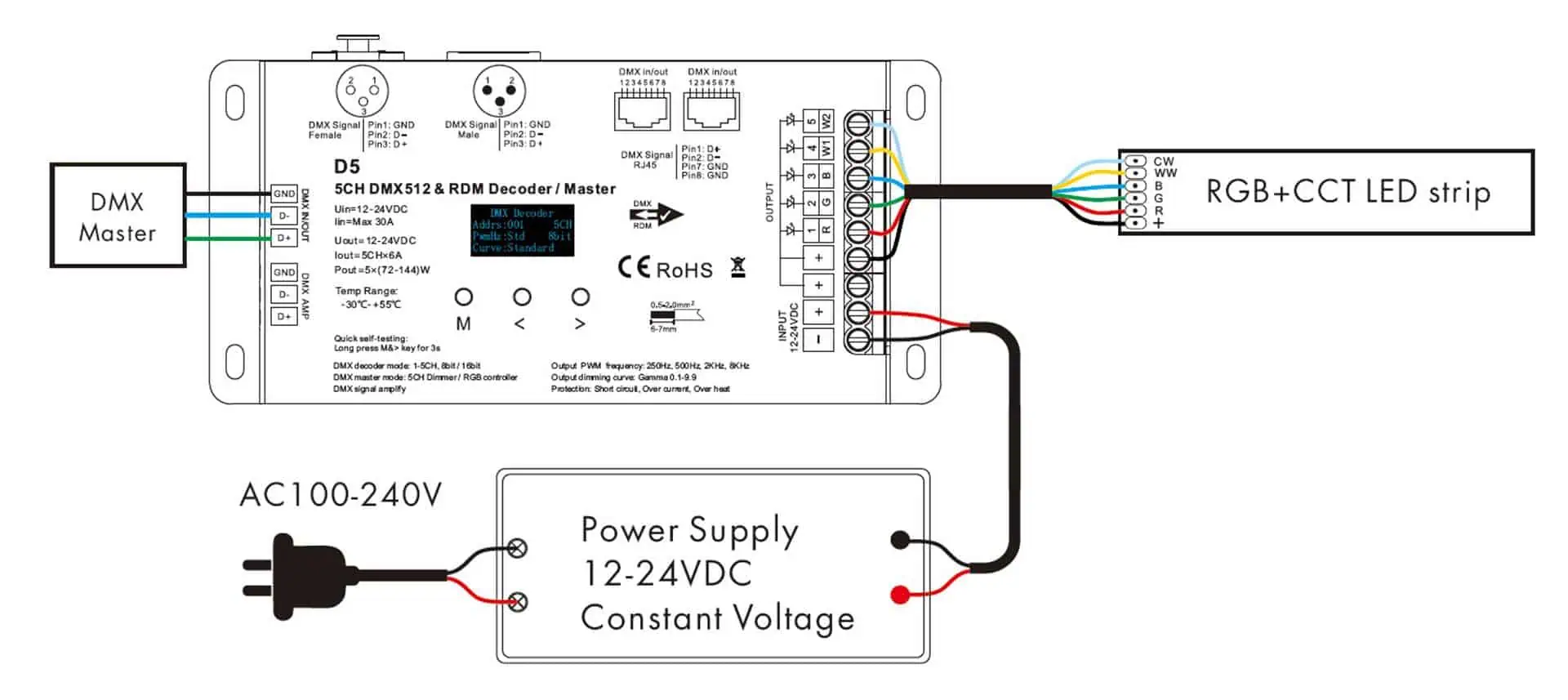
How to Wire Addressable LED Strip Lights
Individual addressable led strip, also called digital led strip, pixel led strip, magic led strip, or dream color led strip, is a led strip with control ICs that allow you to control individual LEDs or groups of LEDs. You can control a specific part of the led strip, which is why it is called ‘addressable’.
For more information, you can read The Ultimate Guide To Addressable LED Strip.
How to Wire SPI Addressable LED Strip Lights
The Serial Peripheral Interface (SPI) is a synchronous serial communication interface specification used for short-distance communication, primarily in embedded systems. The interface was developed by Motorola in the mid-1980s and has become a de facto standard. Typical applications include Secure Digital cards and liquid crystal displays.
The SPI addressable led strip is an LED strip that receives SPI signals directly, and changes the color and brightness of the light according to the signal.
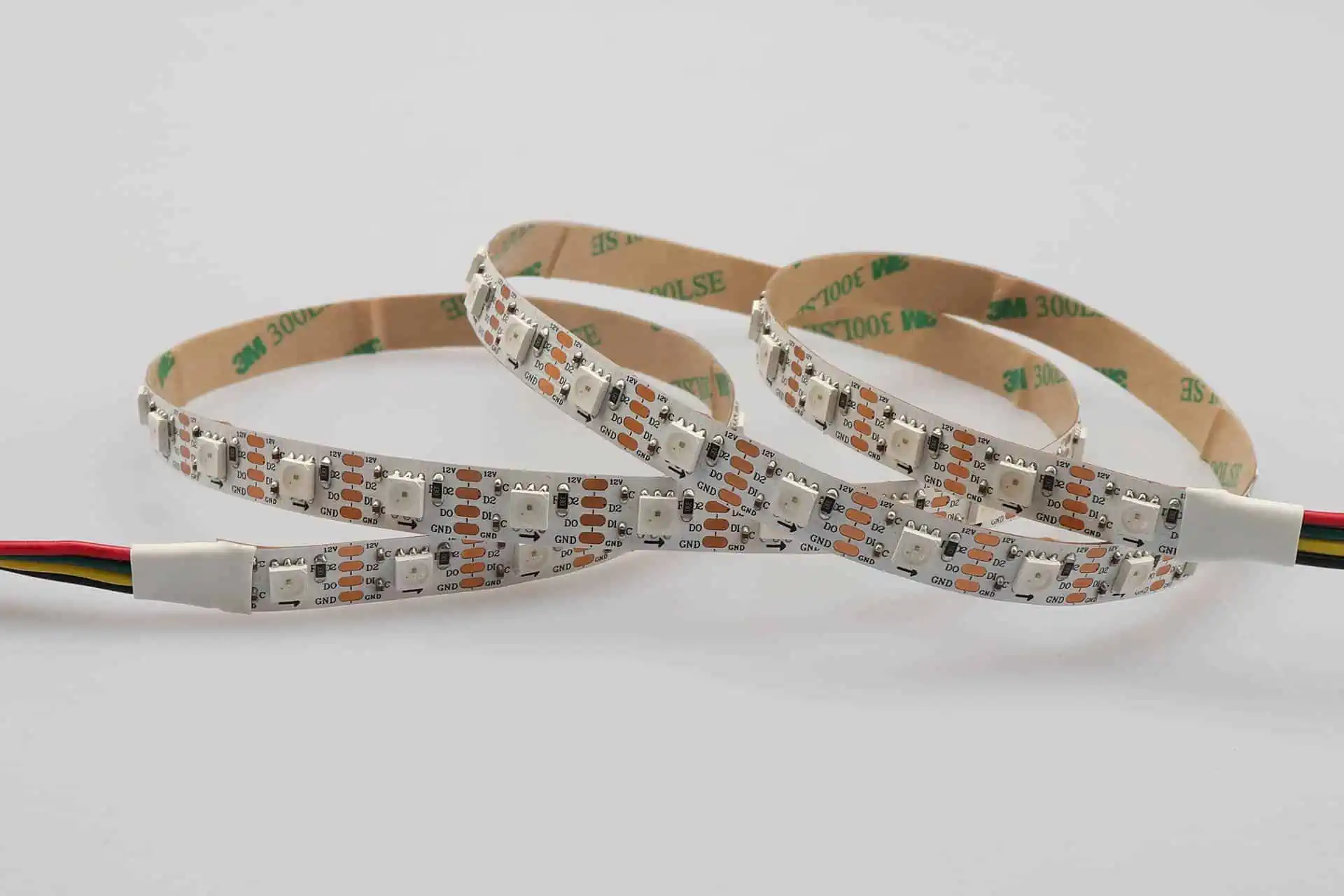
SPI Addressable LED Strip Lights With Data Channel Only

SPI Addressable LED Strip Lights With Data and Clock Channels

SPI Addressable LED Strip Lights With Data and Backup Data Channels

How to Wire DMX512 Addressable LED Strip Lights
The DMX512 addressable led strip is an LED strip that receives DMX512 signals directly, without a DMX512 decoder, and changes the color and brightness of the light according to the signal.
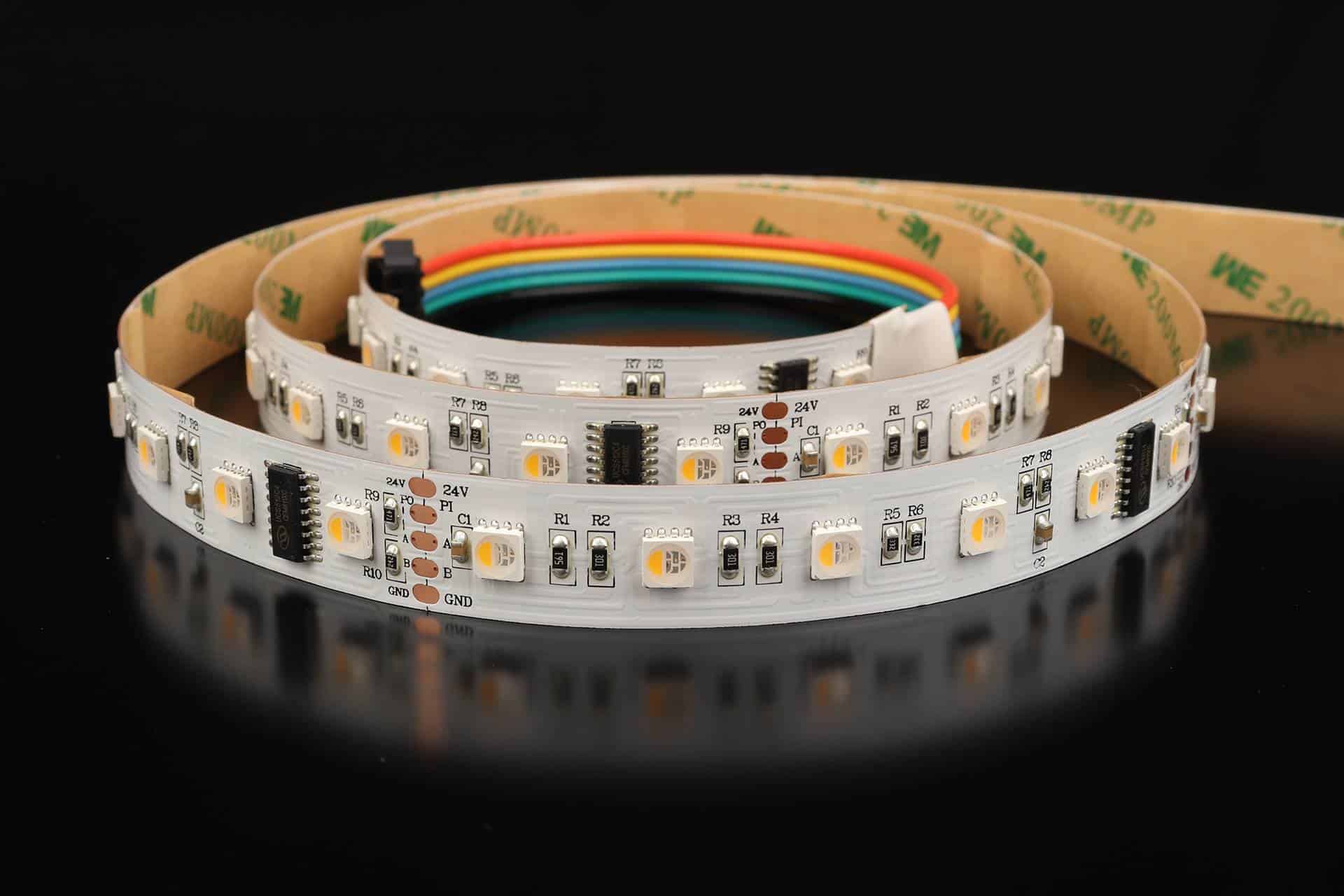
Before using the DMX512 addressable LED strip, you need to set the DMX512 address to the LED strip, and this operation only needs to be done once.

You can download the dmx512 led strip wiring diagram PDF version.
How to Wire High Voltage AC LED Strip Lights
High Voltage AC LED strip lights operate directly from a mains power supply (typically 110V or 220V AC) without the need for a LED transformer. This type of LED strip is ideal for long runs and larger installations. For more information, you can read Low Voltage Vs. High Voltage LED Strips: When to Choose and Why?
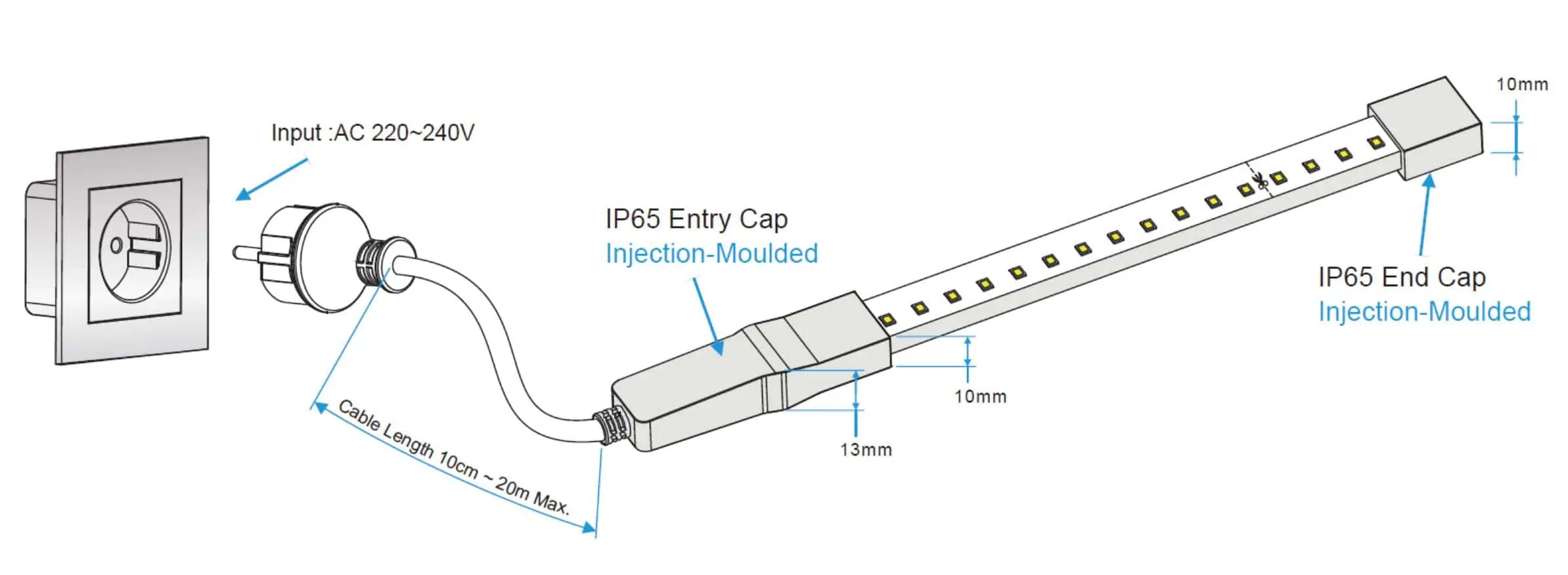
Discover Our LED Neon Flex Demo Kit
By the way, are you struggling to showcase your lighting solutions effectively?
At LEDYi Lighting, we’ve developed the LED Neon Flex Demo Kit to solve this problem. Our kit includes a variety of neon flex samples for easy demonstration of different lighting effects. It’s portable and has a simple plug-and-play setup, making it perfect for impressing clients anywhere.
FAQs
RGB LED light with 4 wires, black, red, green, and blue. The black wire is the positive pole, and red, green, and blue are the negative pole, corresponding to the LED’s red, green, and blue light.
Connect multiple LED strips to the power supply in parallel to avoid voltage drop issues.
You can connect multiple LED strips together, but the length of the series should not exceed 5 meters. If the length of the LED strips in series exceeds 5 meters, both ends need to be connected to the power supply to avoid voltage drop problems. At the same time, it is necessary to ensure that the total LED strip’s power does not exceed 80% of the power supply.
You can connect as many LED strips as you want to a power supply, but you need to connect them in parallel and ensure that the total power of the LED strips does not exceed 80% of the power.
Connecting the LED strips in parallel to the power supply is better, avoiding voltage drop issues.
You can hardwire the LED strips, but connectors are recommended for future maintenance.
You can connect multiple LED strips to a single power supply via connectors or hard-wiring.
LED light strips are generally low-voltage constant voltage 12V or 24V input, so you need a constant voltage output of 12V or 24V power supply.
No, transformers are only required for LED strips with low voltage input. For high-voltage LED strips, it can be directly connected to the mains, 110Vac or 220Vac.
Do not wire low-voltage LED strips to the wall switch. Because the voltage output by the wall switch is 110Vac or 220Vac, this will destroy the low-voltage LED strip. But you can connect the high-voltage LED strip to the wall switch.
The tunable white LED strip has 3 wires: brown, white, and yellow. The brown wire is the positive pole of the led strip, and the white and yellow are the negative pole of the led strip, corresponding to white light and warm white light, respectively.
A single-color LED strip light has 2 wires, usually red and black, corresponding to positive and negative.
Conclusion
I believe that after reading this article, you already have an understanding of how to wire different kinds of LED strip lights.
LEDYi manufactures high-quality LED strips and LED neon flex. All of our products go through high-tech laboratories to ensure the utmost quality. Besides, we offer customizable options on our LED strips and neon flex. So, for premium LED strip and LED neon flex, contact LEDYi ASAP!
